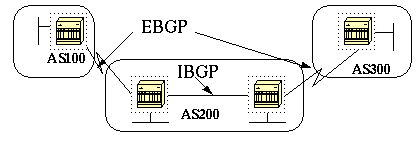
The Border Gateway Protocol (BGP), defined in RFC 1771, allows you to create loop free interdomain routing between autonomous systems. An autonomous system is a set of routers under a single technical administration. Routers in an AS can use multiple interior gateway protocols to exchange routing information inside the AS and an exterior gateway protocol to route packets outside the AS.
BGP uses TCP as its transport protocol (port 179). Two BGP speaking routers form a TCP connection between one another (peer routers) and exchange messages to open and confirm the connection parameters.
BGP routers will exchange network reachability information, this information is mainly an indication of the full paths (BGP AS numbers) that a route should take in order to reach the destination network. This information will help in constructing a graph of ASs that are loop free and where routing policies can be applied in order to enforce some restrictions on the routing behavior.
Any two routers that have formed a TCP connection in order to exchange BGP routing information are called peers, they are also called neighbors.
BGP peers will initially exchange their full BGP routing tables. From then on incremental updates are sent as the routing table changes. BGP keeps a version number of the BGP table and it should be the same for all of its BGP peers. The version number will change whenever BGP updates the table due to some routing information changes. Keepalive packets are sent to ensure that the connection is alive between the BGP peers and notification packets are sent in response to errors or special conditions.
If an Autonomous System has multiple BGP speakers, it could be used as a transit service for other ASs. As you see below, AS200 is a transit autonomous system for AS100 and AS300.
It is necessary to ensure reachability for networks within an AS before sending the information to other external ASs. This is done by a combination of Internal BGP peering between routers inside an AS and by redistributing BGP information to Internal Gateway Protocols running in the AS.
As far as this paper is concerned, when BGP is running between routers belonging to two different ASs we will call it EBGP (Exterior BGP) and for BGP running between routers in the same AS we will call it IBGP (Interior BGP).

Here are the steps needed to enable and configure BGP.
Let us assume you want to have two routers RTA and RTB talk BGP. In the first example RTA and RTB are in different autonomous systems and in the second example both routers belong to the same AS.
We start by defining the router process and define the AS number that the routers belong to. The command used to enable BGP on a router is:
router bgp autonomous-system
RTA#
router bgp 100
RTB#
router bgp 200
The above statements indicates that RTA is running BGP and it belongs to AS100 and RTB is running BGP and it belongs to AS200 and so on.
The next step in the configuration process is to define BGP neighbors. The neighbor definition indicates which routers we are trying to talk with BGP.
The next section will introduce you to what is involved in forming a valid peer connection.
Two BGP routers become neighbors or peers once they establish a TCP connection between one another. The TCP connection is essential in order for the two peer routers to start exchanging routing updates.
Two BGP speaking routers trying to become neighbors will first bring up the TCP connection between one another and then send open messages in order to exchange values such as the AS number, the BGP version they are running (version 3 or 4), the BGP router ID and the keepalive hold time, etc. After these values are confirmed and accepted the neighbor connection will be established. Any state other than established is an indication that the two routers did not become neighbors and hence the BGP updates will not be exchanged.
The neighbor command used to establish a TCP connection is:
neighbor ip-address remote-as number
The remote-as number is the AS number of the router we are trying to connect to via BGP.
The ip-address is the next hop directly connected address for EBGP and any IP address on the other router for IBGP.
It is essential that the two IP addresses used in the neighbor command of the peer routers be able to reach one another. One sure way to verify reachability is an extended ping between the two IP addresses, the extended ping forces the pinging router to use as source the IP address specified in the neighbor command rather than the IP address of the interface the packet is going out from.
It is important to reset the neighbor connection in case any bgp configuration changes are made in order for the new parameters to take effect.
clear ip bgp address (where address is the neighbor
address)
clear ip bgp * (clear all neighbor connections)
By default, BGP sessions begin using BGP Version 4 and negotiating downward to earlier versions if necessary. To prevent negotiations and force the BGP version used to communicate with a neighbor, perform the following task in router configuration mode:
neighbor {ip address|peer-group-name} version value
An example of the neighbor command configuration follows:
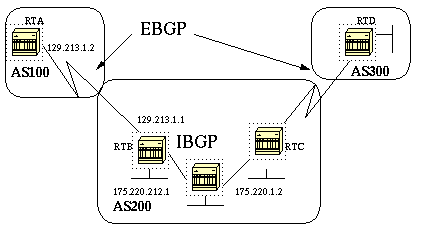
RTA#
router bgp 100
neighbor 129.213.1.1 remote-as 200
RTB#
router bgp 200
neighbor 129.213.1.2 remote-as 100
neighbor 175.220.1.2 remote-as 200
RTC#
router bgp 200
neighbor 175.220.212.1 remote-as 200
In the above example RTA and RTB are running EBGP. RTB and RTC are running IBGP. The difference between EBGP and IBGP is manifested by having the remote-as number pointing to either an external or an internal AS.
Also, the EBGP peers are directly connected and the IBGP peers are not. IBGP routers do not have to be directly connected, as long as there is some IGP running that allows the two neighbors to reach one another.
The following is an example of the information that the command "sh ip bgp neighbors" will show you, pay special attention to the BGP state. Anything other than state established indicates that the peers are not up. You should also note the BGP is version 4, the remote router ID (highest IP address on that box or the highest loopback interface in case it exists) and the table version (this is the state of the table, any time new information comes in, the table will increase the version and a version that keeps incrementing indicates that some route is flapping causing routes to keep getting updated).
#SH IP BGP N
BGP neighbor is 129.213.1.1, remote AS 200, external link
BGP version 4, remote router ID 175.220.12.1
BGP state = Established, table version = 3, up for 0:10:59
Last read 0:00:29, hold time is 180, keepalive interval is 60 seconds
Minimum time between advertisement runs is 30 seconds
Received 2828 messages, 0 notifications, 0 in queue
Sent 2826 messages, 0 notifications, 0 in queue
Connections established 11; dropped 10
In the next section, we will discuss special situations such as EBGP multihop and loopback addresses.
Using a loopback interface to define neighbors is commonly used with IBGP rather than EBGP. Normally the loopback interface is used to make sure that the IP address of the neighbor stays up and is independent of a hardware that might be flaky. In the case of EBGP, most of the time the peer routers are directly connected and loopback does not apply.
If the IP address of a loopback interface is used in the neighbor command, some extra configuration needs to be done on the neighbor router. The neighbor router needs to tell BGP that it is using a loopback interface rather than a physical interface to initiate the BGP neighbor TCP connection. The command used to indicate a loopback interface is:
neighbor ip-address update-source interface
The following example should illustrate the use of this command.

RTA#
router bgp 100
neighbor 190.225.11.1 remote-as 100
neighbor 190.225.11.1 update-source int loopback 1
RTB#
router bgp 100
neighbor 150.212.1.1 remote-as 100
In the above example, RTA and RTB are running internal BGP inside autonomous system 100. RTB is using in its neighbor command the loopback interface of RTA (150.212.1.1); in this case RTA has to force BGP to use the loopback IP address as the source in the TCP neighbor connection. RTA will do so by adding the update-source int loopback configuration (neighbor 190.225.11.1 update-source int loopback 1) and this statement forces BGP to use the ip address of its loopback interface when talking to neighbor 190.225.11.1.
Note that RTA has used the physical interface IP address (190.225.11.1) of RTB as a neighbor and that is why RTB does not need to do any special configuration.
In some special cases, the Cisco router could be running external BGP with a third party router that does not allow the two external peers to be directly connected. In this case EBGP multihop is used to allow the neighbor connection to be established between two non directly connected external peers. The multihop is used only for external BGP and not for internal BGP. The following example gives a better illustration of EBGP multihop.

RTA#
router bgp 100
neighbor 180.225.11.1 remote-as 300
neighbor 180.225.11.1 ebgp-multihop
RTB#
router bgp 300
neighbor 129.213.1.2 remote-as 100
RTA is indicating an external neighbor that is not directly connected. RTA needs to indicate that it will be using ebgp-multihop. On the other hand, RTB is indicating a neighbor that is directly connected (129.213.1.2) and that is why it does not need the ebgp-multihop command. Some IGP or static routing should also be configured in order to allow the non connected neighbors to reach eachother.
The following example shows how to achieve load balancing with BGP in a particular case where we have EBGP over parallel lines.
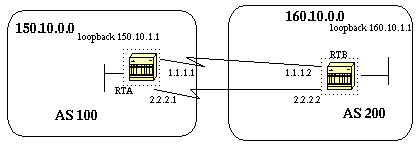
RTA#
int loopback 0
ip address 150.10.1.1 255.255.255.0
router bgp 100
neighbor 160.10.1.1 remote-as 200
neighbor 160.10.1.1 ebgp-multihop
neighbor 160.10.1.1 update-source loopback 0
network 150.10.0.0
ip route 160.10.0.0 255.255.0.0 1.1.1.2
ip route 160.10.0.0 255.255.0.0 2.2.2.2
RTB#
int loopback 0
ip address 160.10.1.1 255.255.255.0
router bgp 200
neighbor 150.10.1.1 remote-as 100
neighbor 150.10.1.1 update-source loopback 0
neighbor 150.10.1.1 ebgp-multihop
network 160.10.0.0
ip route 150.10.0.0 255.255.0.0 1.1.1.1
ip route 150.10.0.0 255.255.0.0 2.2.2.1
The above example illustrates the use of loopback interfaces, update-source and ebgp-multihop. This is a workaround in order to achieve load balancing between two EBGP speakers over parallel serial lines. In normal situations, BGP will pick one of the lines to send packets on and load balancing would not take place. By introducing loopback interfaces, the next hop for EBGP will be the loopback interface. Static routes (it could be some IGP also) are used to introduce two equal cost paths to reach the destination. RTA will have two choices to reach next hop 160.10.1.1: one via 1.1.1.2 and the other one via 2.2.2.2 and the same for RTB.
At this point I would like to introduce route maps because they will be used heavily with BGP. In the BGP context, route map is a method used to control and modify routing information. This is done by defining conditions for redistributing routes from one routing protocol to another or controlling routing information when injected in and out of BGP. The format of the route map follows:
route-map map-tag [[permit | deny] | [sequence-number]]
The map-tag is just a name you give to the route-map. Multiple instances of the same route map (same name-tag) can be defined. The sequence number is just an indication of the position a new route map is to have in the list of route maps already configured with the same name.
For example, if I define two instances of the route map, let us call it MYMAP, the first instance will have a sequence-number of 10, and the second will have a sequence number of 20.
route-map MYMAP permit 10
(first set of conditions goes here.)
route-map MYMAP permit 20
(second set of conditions goes here.)
When applying route map MYMAP to incoming or outgoing routes, the first
set of conditions will be applied via instance 10. If the first set of
conditions is not met then we proceed to a higher instance of the route map.
For example, I could define a route map that checks outgoing updates and
if there is a match for IP address 1.1.1.1 then the metric for that update
will be set to 5. The above can be illustrated by the following commands:
match ip address 1.1.1.1
Now, if the match criteria are met and we have a permit then the
routes will be redistributed or controlled as specified by the set action
and we break out of the list.
If the match criteria are met and we have a deny then the route will
not be redistributed or controlled and we break out of the list.
If the match criteria are not met and we have a permit or deny
then the next instance of the route map (instance 20 for example) will be
checked, and so on until we either break out or finish all the instances of
the route map. If we finish the list without a match then the route we are
looking at will not be accepted nor forwarded.
One restriction on route maps is that when used for filtering BGP
updates (as we will see later) rather than when redistributing between
protocols, you can NOT filter on the inbound when using a "match" on the ip
address. Filtering on t
he outbound is OK.
The related commands for match are:
match as-path
The related commands for set are:
Let's look at some route-map examples:
Example 1:
Assume RTA and RTB are running rip; RTA and RTC are running BGP. RTA is
getting updates via BGP and redistributing them to rip. If RTA wants to
redistribute to RTB routes about 170.10.0.0 with a metric of 2 and all
other routes with a metric of 5 then we might use the following
configuration:
RTA#
router bgp 100
route-map SETMETRIC permit 10
route-map SETMETRIC permit 20
access-list 1 permit 170.10.0.0 0.0.255.255
In the above example if a route matches the IP address 170.10.0.0 it
will have a metric of 2 and then we break out of the route map list. If
there is no match then we go down the route map list which says, set
everything else to metric 5. It is always very important to ask the
question, what will happen to routes that do not match any of the match
statements because they will be dropped by default.
Example 2:
Suppose in the above example we did not want AS100 to accept updates
about 170.10.0.0. Since route maps cannot be applied on the inbound when
matching based on an ip address, we have to use an outbound route map on
RTC:
Now that you feel more comfortable with how to start BGP and how to
define a neighbor, let's look at how to start exchanging network information.
There are multiple ways to send network information using BGP. I will go
The format of the network command follows:
network network-number [mask network-mask]
The network command controls what networks are originated by this box.
This is a different concept from what you are used to configuring with IGRP
and RIP. With this command we are not trying to run BGP on a certain
interface, rather we are trying to indicate to BGP what networks it should
originate from this box. The mask portion is used because BGP4 can handle
subnetting and supernetting. A maximum of 200 entries of the network
command are accepted.
The network command will work if the network you are trying to
advertise is known to the router, whether connected, static or learned
dynamically.
An example of the network command follows:
RTA#
ip route 192.213.0.0 255.255.0.0 null 0
The above example indicates that router A, will generate a network entry
for 192.213.0.0/16. The /16 indicates that we are using a supernet of the
class C address and we are advertizing the first two octets (the first 16
bits).
Note that we need the static route to get the router to generate
192.213.0.0 because the static route will put a matching entry in the
routing table.
The network command is one way to advertise your networks via BGP.
Another way is to redistribute your IGP (IGRP, OSPF, RIP, EIGRP, etc.)
into BGP. This sounds scary because now you are dumping all of your
internal routes into BGP, some of these routes might have been learned via
BGP and you do not need to send them out again. Careful filtering should be
applied to make sure you are sending to the internet only routes that you
want to advertise and not
everything you have. Let us look at the example below.
RTA is announcing 129.213.1.0 and RTC is announcing 175.220.0.0. Look at
RTC's configuration:
If you use a network command you will have:
RTC#
router bgp 200
If you use redistribution instead you will have:
RTC#
router bgp 200
This will cause 129.213.1.0 to be originated by your AS. This is
misleading because you are not the source of 129.213.1.0 but AS100 is.
So you would have to use filters to prevent that network from being sourced
out by your AS. The correct configuration would be:
RTC#
router bgp 200
access-list 1 permit 175.220.0.0 0.0.255.255
The access-list is used to control what networks are to be originated
from AS200.
You could always use static routes to originate a network or a subnet.
The only difference is that BGP will consider these routes as having an
origin of incomplete (unknown). In the above example the same could have
been accomplished by doing:
RTC#
router bgp 200
The null 0 interface means disregard the packet. So if I get the packet
and there is a more specific match than 175.220.0.0 (which exists of course)
the router will send it to the specific match otherwise it will disregard
it. This is a nice way to advertise a supernet.
We have discussed how we can use different methods to originate routes
out of our autonomous system. Please remember that these routes are
generated in addition to other BGP routes that BGP has learned via
neighbors (internal or external). BGP passes on information that it learns
from one peer to other peers. The difference is that routes generated by
the network command, or redistribution or static, will indicate your AS as
the origin for these networks.
Injecting BGP into IGP is always done by redistribution.
Example:
RTA#
RTB#
RTC#
Note that you do not need network 150.10.0.0 or network 160.10.0.0 in
RTC unless you want RTC to also generate these networks on top of passing
them on as they come in from AS100 and AS200. Again the difference is that
the network command will add an extra advertisement for these same networks
indicating that AS300 is also an origin for these routes.
An important point to remember is that BGP will not accept updates
that have originated from its own AS. This is to insure a loop free
interdomain topology.
For example, assume AS200 above had a direct BGP connection into
AS100. RTA will generate a route 150.10.0.0 and will send it to AS300 then
RTC will pass this route to AS200 with the origin kept as AS100, RTB will
pass 150.10.0.0 to AS100 with origin still AS100. RTA will notice that the
update has originated from its own AS and will ignore it.
IBGP is used if an AS wants to act as a transit system to other
ASs. You might ask, why can't we do the same thing by learning via EBGP
redistributing into IGP and then redistributing again into another AS? We
can, but IBGP offers more flexibility and more efficient ways to exchange
information within an AS; for example IBGP provides us with ways to control
what is the best exit point out of the AS by using local preference (will be
discussed later).
RTA#
RTB#
RTC#
An important point to remember, is that when a BGP speaker receives an
update from other BGP speakers in its own AS (IBGP), the receiving BGP
speaker will not redistribute that information to other BGP speakers in its
own AS. The receiving BGP speaker will redistribute that information to
other BGP speakers outside of its AS. That is why it is important to
sustain a full mesh between the IBGP speakers within an AS.
In the above diagram, RTA and RTB are running IBGP and RTA and RTD
are running IBGP also. The BGP updates coming from RTB to RTA will be sent
to RTE (outside of the AS) but not to RTD (inside of the AS). This is why an
IBGP peering should be made between RTB and RTD in order not to break the
flow of the updates.
After BGP receives updates about different destinations from
different autonomous systems, the protocol will have to decide which paths
to choose in order to reach a specific destination. BGP will choose only
a single path to reach a specific destination.
The decision process is based on different attributes, such as
next hop, administrative weights, local preference, the route origin, path
length, origin code, metric and so on.
BGP will always propagate the best path to its neighbors.
In the following section I will try to explain these attributes and
show how they are used. We will start with the path attribute.
(End of section 1)
Whenever a route update passes through an AS, the AS number is
prepended to that update. The AS_path attribute is actually the list
of AS numbers that a route has traversed in order to reach a destination. An
AS-SET is an ordered mathematical set {} of all the ASs that have
been traversed. An example of AS-SET is given later.
In the above example, network 190.10.0.0 is advertised by RTB in AS200,
when that route traverses AS300 and RTC will append its own AS number to
it. So when 190.10.0.0 reaches RTA it will have two AS numbers attached to
it: first 200 then 300. So as far as RTA is concerned the path to reach
190.10.0.0 is (300,200).
The same applies for 170.10.0.0 and 180.10.0.0. RTB will have to take
path (300,100) i.e. traverse AS300 and then AS100 in order to reach
170.10.0.0. RTC will have to traverse path (200) in order to reach
190.10.0.0 and path (100) in order to reach 170.10.0.0.
The origin is a mandatory attribute that defines the origin of the path
information. The origin attribute can assume three values:
IGP: Network Layer Reachability Information (NLRI) is interior to the
originating AS. This normally happens when we use the bgp network command or
when IGP is redistributed into BGP, then the origin of the path info will
be IGP. This is indicated with an "i" in the BGP table.
EGP: NLRI is learned via EGP (Exterior Gateway Protocol). This is
INCOMPLETE: NLRI is unknown or learned via some other means. This usually
occurs when we redistribute a static route into BGP and the origin of the
route will be incomplete. This is indicated with an "?" in the BGP table.
Example:
RTA#
RTB#
RTE#
RTA will reach 170.10.0.0 via: 300 i (which means the next AS path is
300 and the origin of the route is IGP).
The BGP nexthop attribute is the next hop IP address that is going to
be used to reach a certain destination.
For EBGP, the next hop is always the IP address of the neighbor specified
in the neighbor command. In the above example, RTC will advertise 170.10.0.0
to RTA with a next hop of 170.10.20.2 and RTA will advertise 150.10.0.0 to
RTC with a next hop of 170.10.20.1. For IBGP, the protocol states that
the next hop advertised by EBGP should be carried into IBGP. Because of
that rule, RTA will advertise 170.10.0.0 to its IBGP peer RTB with a next
hop of 170.10.20.2. So according to RTB, the next hop to reach 170.10.0.0
is 170.10.20.2 and NOT 150.10.30.1.
You should make sure that RTB can reach 170.10.20.2 via IGP, otherwise RTB
will drop packets destined to 170.10.0.0 because the next hop address would
be inaccessible. For example, if RTB is running IGRP you could also run igrp
on RTA network 170.10.0.0. You would want to make IGRP passive on the link
to RTC so BGP is only exchanged.
Example:
RTA#
RTB#
RTC#
*RTC will advertise 170.10.0.0 to RTA with a NextHop 170.10.20.2
Special care should be taken when dealing with multiaccess and NBMA
networks as described in the following sections.
The following example shows how the nexthop will behave on a multiaccess
network such as ethernet.
Assume that RTC and RTD in AS300 are running OSPF. RTC is running BGP with
RTA. RTC can reach network 180.20.0.0 via 170.10.20.3. When RTC sends a BGP
update to RTA regarding 180.20.0.0 it will use as next hop 170.10.20.3 and
not its own IP address (170.10.20.2). This is because the network between
RTA, RTC and RTD is a multiaccess network and it makes more sense for RTA to
use RTD as a next hop to reach 180.20.0.0 rather than making an extra hop
via RTC.
*RTC will advertise 180.20.0.0 to RTA with a NextHop 170.10.20.3.
If the common media to RTA, RTC and RTD was not multiaccess, but NBMA
(Non Broadcast Media Access) then further complications will occur.
If the common media as you see in the shaded area above is a frame
relay or any NBMA cloud then the exact behavior will occur as if we were
connected via ethernet. RTC will advertise 180.20.0.0 to RTA with a next hop
of 170.10.20.3.
The problem is that RTA does not have a direct PVC to RTD, and cannot
reach the next hop. In this case routing will fail.
In order to remedy this situation a command called NextHopself is created.
Because of certain situations with the nexthop as we saw in the previous
example, a command called next-hop-self is created. The syntax is:
neighbor {ip-address|peer-group-name}
next-hop-self
The next-hop-self command will allow us to force BGP to use a
specified IP address as the next hop rather than letting the protocol choose
the nexthop.
In the previous example the following will solve our problem:
RTC#
RTC will advertise 180.20.0.0 with a NextHop = 170.10.20.2
Consider the above diagram, RTA and RTC are running EBGP and RTB
and RTC are running EBGP. RTA and RTB are running some kind of IGP (RIP,
IGRP, etc.). By definition, EBGP updates have a distance of 20 which is
lower than the IGP distances. Default distance is 120 for RIP, 100 for
IGRP, 90 for EIGRP and 110 for OSPF. RTA will receive updates about
160.10.0.0 via two routing protocols:
By default, BGP has the following distances, but that could be changed
by the distance command:
distance bgp external-distance internal-distance local-distance
external-distance:20
RTA will pick EBGP via RTC because of the lower distance.
If we want RTA to learn about 160.10.0.0 via RTB (IGP), then we have two
options:
1- Change EBGP's external distance or IGP's distance which is NOT
recommended.
2- Use BGP backdoor
BGP backdoor will make the IGP route, the preferred route.
Use the following command: network address backdoor.
The configured network is the network that we would like to reach via
IGP. For BGP this network will be treated as a locally assigned network
except it will not be advertised in BGP updates.
Example:
RTA#
router bgp 100
Network 160.10.0.0 will be treated as a local entry but will not be
advertised as a normal network entry would.
RTA will learn 160.10.0.0 from RTB via EIGRP with distance 90, and will
also learn it from RTC via EBGP with distance 20. Normally EBGP will be
preferred, but because of the backdoor command EIGRP will be preferred.
Before we discuss synchronization let us look at the following scenario.
RTC in AS300 is sending updates about 170.10.0.0. RTA and RTB are running
IBGP, so RTB will get the update and will be able to reach 170.10.0.0 via
next hop 2.2.2.1 (remember that the next hop is carried via IBGP). In order
to reach the next hop, RTB will have to send the traffic to RTE.
Assume that RTA has not redistributed network 170.10.0.0 into IGP, so at
this point RTE has no idea that 170.10.0.0 even exists.
If RTB starts advertising to AS400 that he can reach 170.10.0.0 then
traffic coming from RTD to RTB with destination 170.10.0.0 will flow in and
get dropped at RTE.
Synchronization states: If your autonomous system is passing traffic from
another AS to a third AS, BGP should not advertise a route before all
routers in your AS have learned about the route via IGP.
In the above example, RTB will wait to hear about 170.10.0.0 via IGP
before it starts sending the update to RTD. We can fool RTB into thinking
that IGP has propagated the information by adding a static route in RTB
pointing to 170.10.0.0. Care should be taken to make sure that other routers
can reach 170.10.0.0 otherwise we will have a problem reaching that network.
In some cases you do not need synchronization. If you will not be passing
traffic from a different autonomous system through your AS, or if all routers
in your AS will be running BGP, you can disable synchronization. Disabling
this feature can allow you to carry fewer routes in your IGP and allow BGP
to converge more quickly.
Disabling synchronization is not automatic, if you have all your routers
in the AS running BGP and you are not running any IGP, the router has no way
of knowing that, and your router will be waiting forever for an IGP update
about a certain route before sending it to external peers. You have to
disable synchronization manually in this case for routing to work correctly:
router bgp 100
(Make sure you do a clear ip bgp address to reset the
session)
Example:
RTB#
RTD#
RTA#
The weight attribute is a Cisco defined attribute. The weight is
used for a best path selection process. The weight is assigned locally to the
router. It is a value that only makes sense to the specific router and which
is not propagated or carried through any of the route updates. A weight can
be a number from 0 to 65535. Paths that the router originates have a weight
of 32768 by default and other paths have a weight of zero.
Routes with a higher weight are preferred when multiple routes exist to
the same destination. Let us study the above example. RTA has learned about
network 175.10.0.0 from AS4 and will propagate the update to RTC. RTB has
also learned about network 175.10.0.0 from AS4 and will propagate it to
RTC. RTC has now two ways for reaching 175.10.0.0 and has to decide which
way to go. If on RTC we can set the weight of the updates coming from RTA
to be higher than the weight of updates coming from RTB, then we will force
RTC to use RTA as a next hop to reach 175.10.0.0. This is achieved by using
multiple methods:
1- Using the neighbor command
neighbor {ip-address|peer-group} weight
weight
2- Using AS path access-lists
ip as-path access-list access-list-number {permit|deny}
as-regular-expression
3-Using route-maps
example:
RTC#
*Routes with higher weight are preferred when multiple routes exist to
the same destination. RTA will be preferred as the next hop.
The same outcome can be achieved via ip as-path and filter lists.
RTC#
The same outcome as above can be achieved by using routmaps.
RTC#
route-map setweightin permit 10
route-map setweightin permit 20
Local preference is an indication to the AS about which path is preferred
to exit the AS in order to reach a certain network. A path with a higher
local preference is more preferred. The default value for local preference
is 100.
Unlike the weight attribute which is only relevant to the local router,
local preference is an attribute that is exchanged among routers in the
same AS.
Local preference is set via the "bgp default local-preference <
value>" command or with route-maps as will be demonstrated in the
following example:
The bgp default local-preference RTC#
RTD#
In the above configuration RTC will set the local preference of all
updates to 150. The same RTD will set the local preference of all updates to
200. Since local preference is exchanged within AS256, both RTC and RTD will
realize that network 170.10.0.0 has a higher local preference when coming
from AS300 rather than when coming from AS100. All traffic in AS256 addressed
to that network will be sent to RTD as an exit point.
More flexibility is provided by using route maps. In the above example,
all updates received by RTD will be tagged with local preference 200 when
they reach RTD. This means that updates coming from AS34 will also be
tagged with the local preference of 200. This might not be needed. This is
why we can use route maps to specify what specific updates need to be tagged
with a specific local preference as shown below:
RTD#
route-map setlocalin permit 10
route-map setlocalin permit 20
With this configuration, any update coming from AS300 will be set with a
local preference of 200. Any other updates such as those coming from AS34
will be set with a value of 150.
The metric attribute which is also called Multi_exit_discriminator, MED
(BGP4) or Inter-As (BGP3) is a hint to external neighbors about the
preferred path into an AS. This is a dynamic way to influence another AS on
which way to choose in order to reach a certain route given that we have
multiple entry points into that AS. A lower value of a metric is more
preferred.
Unlike local preference, metric is exchanged between ASs. A metric is
carried into an AS but does not leave the AS. When an update enters the AS
with a certain metric, that metric is used for decision making inside the
AS. When the same update is passed on to a third AS, that metric will be
set back to 0 as shown in the above diagram. The Metric default value is 0.
Unless otherwise specified, a router will compare metrics for paths from
neighbors in the same AS. In order for the router to compare metrics from
neighbors coming from different ASs the special configuration command "bgp
always-compare-med" should be configured on the router.
In the above diagram, AS100 is getting information about network
180.10.0.0 via three different routers: RTC, RTD and RTB.
RTC and RTD are in AS300 and RTB is in AS400.
Assume that we have set the metric coming from RTC to 120, the metric
coming from RTD to 200 and the metric coming from RTB to 50. Given that by
default a router compares metrics coming from neighbors in the same AS, RTA
can only compare the metric coming from RTC to the metric coming from RTD
and will pick RTC as the best next hop because 120 is less than 200. When
RTA gets an update from RTB with metric 50, he can not compare it to 120
because RTC and RTB are in different ASs (RTA has to choose based on some
other attributes). In order to force RTA to compare the metrics we have
to add
bgp always-compare-med to RTA. This is illustrated in the configs
below:
RTA#
RTC#
route-map setmetricout permit 10
RTD#
route-map setmetricout permit 10
RTB#
route-map setmetricout permit 10
With the above configs, RTA will pick RTC as next hop, considering all
other attributes are the same. In order to have RTB included in the metric
comparison, we have to configure RTA as follows:
RTA#
In this case RTA will pick RTB as the best next hop in order to reach
network 180.10.0.0.
Metric can also be set while redistributing routes into BGP, the command is:
default-metric number
Assume in the above example that RTB is injecting a network via
static into AS100 then the following configs:
RTB#
will cause RTB to send out 180.10.0.0 with a metric of 50.
The community attribute is a transitive, optional attribute in the
range 0 to 4,294,967,200. The community attribute is a way to group
destinations in a certain community and apply routing decisions (accept,
prefer, redistribute, etc.) according to those communities.
We can use route maps to set the community attributes. The route map set
command has the following syntax:
set community community-number [additive]
A few predefined well known communities (community-number) are:
-no-export (Do not advertise to EBGP peers)
An example of route maps where community is set is:
route-map communitymap
or
route-map setcommunity
If the additive keyword is not set, 200 will replace any old community
that already exits; if we use the keyword additive then the 200 will be
added to the community.
Even if we set the community attribute, this attribute will not be
sent to neighbors by default.
In order to send the attribute to our neighbor we have to use the
following:
neighbor {ip-address|peer-group-name} send-community
Example:
RTA#
Sending and receiving BGP updates can be controlled by using a
number of different filtering methods. BGP updates can be filtered based on
route information, on path information or on communities. All methods will
achieve the same results, choosing one over the other depends on the
specific network configuration.
In order to restrict the routing information that the router
learns or advertises, you can filter BGP based on routing updates to or
from a particular neighbor. In order to achieve this, an access-list is
defined and applied to the updates to or from a neighbor. Use the following
command in the router configuration mode:
Neighbor {ip-address|peer-group-name}
distribute-list access-list-number {in | out}
In the following example, RTB is originating network 160.10.0.0 and
sending it to RTC. If RTC wanted to stop those updates from propagating to
AS100, we would have to apply an access-list to filter those updates and
apply it when talking to RTA:
RTC#
access-list 1 deny 160.10.0.0 0.0.255.255
access-list 1 permit 0.0.0.0 255.255.255.255
Using access-lists is a bit tricky when we are dealing with supernets
that might cause some conflicts.
Assume in the above example that RTB has different subnets of 160.10.X.X
and our goal is to filter updates and advertise only 160.0.0.0/8 (this
notation means that we are using 8 bits of subnet mask starting from the
far left of the IP address; this is equivalent to 160.0.0.0 255.0.0.0)
The following access list:
access-list 1 permit 160.0.0.0 0.255.255.255
will permit 160.0.0.0/8,160.0.0.0/9 and so on. In order to restrict the
update to only 160.0.0.0/8 we have to use an extended access list of the
following format:
access-list ex: access-list 101 160.0.0.0 0.255.255.255 255.0.0.0 0.0.0.0
This list will permit 160.0.0.0/8 only.
Another type of filtering, is path filtering which is described in the
next section.
You can specify an access list on both incoming and outgoing
updates based on the BGP autonomous system paths information. In the above
figure we can block updates about 160.10.0.0 from going to AS100 by
defining an access list on RTC that prevents any updates that have
originated from AS200 from being sent to AS100. To do this use the
following statements.
ip as-path access-list access-list-number
{permit|deny} as-regular-expression
neighbor {ip-address|peer-group-name}
filter-list access-list-number {in|out}
The following example will stop RTC from sending RTA updates about
160.10.0.0
RTC#
ip as-path access-list 1 deny ^200$
In the above example, access-list 1 states: deny any updates with path
information that start with 200 (^) and end with 200 ($). The ^200$ is
called a regular expression, with ^ meaning starts with and $ meaning ends
with. Since RTB sends updates about 160.10.0.0 with path information
starting with 200 and ending with 200, then this update will match the
access list and will be denied.
The .* is another regular expression with the dot meaning any character
and the * meaning the repetition of that character. So .* is actually any
path information, which is needed to permit all other updates to be sent.
What would happen if instead of using ^200$ we have used ^200
A good way to check whether we have implemented the correct regular
expression is to do:
sh ip bgp regexp <regular expression>.
This will show us all the path that has matched the configured regular
expression.
Regular expressions sound a bit complicated but actually they are not.
The next section will explain what is involved in creating a regular
expression.
A regular expression is a pattern to match against an input string. By
building a regular expression we specify a string that input must match. In
case of BGP we are specifying a string consisting of path information that
an input should match.
In the previous example we specified the string ^200$ and wanted path
information coming inside updates to match it in order to perform a decision.
The regular expression is composed of the following:
A- Ranges:
B- Atoms
. (Matches any single character)
C-Pieces
* (Matches 0 or more sequences of the atom)
D- Branch
Examples of regular expressions follow:
a* any occurrence of the letter a, including none
ex:
We have already seen route filtering and as-path filtering. Another
method is community filtering. Community has been discussed previously and
here are few examples of how we can use it.
We would like RTB above to set the community attribute to the BGP routes
it is advertising such that RTC would not propagate these routes to its
external peers. The no-export community attribute is used:
RTB#
route-map setcommunity
access-list 1 permit 0.0.0.0 255.255.255.255
Note that we have used the route-map setcommunity in order to set the
community to no-export. Note also that we had to use the "neighbor
send-community" command in order to send this attribute to RTC.
When RTC gets the updates with the attribute no-export, it will not
propagate them to its external peer RTA.
Example 2:
RTB#
route-map setcommunity
access-list 2 permit 0.0.0.0 255.255.255.255
In the above example, RTB has set the community attribute to 100 200
additive. The value 100 200 will be added to any existing community value
before being sent to RTC.
A community list is a group of communities that we use in a match
clause of a route map which allows us to do filtering or setting attributes
based on different lists of community numbers.
ip community-list community-list-number
{permit|deny} community-number
For example we can define the following route map, match-on-community:
route-map match-on-community
ip community-list 10 permit 200 300 (200 300 is the community number)
We can use the above in order to filter or set certain parameters like
weight and metric based on the community value in certain updates. In
example two above, RTB was sending updates to RTC with a community of 100
200. If RTC wants to set the weight based on those values we could do the
following:
RTC#
route-map check-community permit 10
route-map check-community permit 20
route-map check-community permit 30
ip community-list 1 permit 100
In the above example, any route that has 100 in its community attribute
will match list 1 and will have the weight set to 20. Any route that has
only 200 as community will match list 2 and will have weight 20. The
keyword exact states that community should consist of 200 only and
nothing else. The last community list is here to make sure that other
updates are not dropped. Remember that anything that does not match, will
be dropped by default. The keyword internet means all routes because
all routes are
members of the internet community.
The neighbor command can be used in conjunction with route maps to
perform either filtering or parameter setting on incoming and outgoing
updates.
Route maps associated with the neighbor statement have no affect on
incoming updates when matching based on the IP address:
neighbor ip-address route-map route-map-name
Assume in the above diagram we want RTC to learn from AS200 about
networks that are local to AS200 and nothing else. Also, we want to set the
weight on the accepted routes to 20. We can achieve this with a combination
of neighbor and as-path access lists.
Example 1:
RTC#
route-map stamp
ip as-path access-list 1 permit ^200$
Any updates that originate from AS200 have a path information that
starts with 200 and ends with 200 and will be permitted. Any other updates
will be dropped.
Example 2:
Assume that we want the following:
RTC#
route-map stamp permit 10
route-map stamp permit 20
ip as-path access-list 1 permit ^200$
The above statement will set a weight of 20 for updates that are local
to AS200, and will set a weight of 10 for updates that are behind AS400
and will drop updates coming from AS400.
In some situations we are forced to manipulate the PATH information
in order to manipulate the BGP decision process. The command that is used
with a route map is:
set as-path prepend Suppose in the above diagram that RTC is advertising its own network
170.10.0.0 to two different ASs: AS100 and AS200. When the information is
propagated to AS600, the routers in AS600 will have network reachability
information about 150.10.0.0 via two different routes, the first route is
via AS100 with PATH (100, 300) and the second one is via AS400 with PATH
(400, 200,300). Assuming that all other attributes are the same AS600 will
pick the shortest path and will choose the route via AS100.
AS300 will be getting all its traffic via AS100. If we want to influence
this decision from the AS300 end we can make the PATH through AS100 look
like it is longer than the PATH going through AS400. We can do this by
prepending autonomous system numbers to the existing path info advertised
to AS100. A common practice is to repeat our own AS number using the
following:
RTC#
route-map SETPATH
Because of the above configuration, AS600 will receive updates about
170.10.0.0 via AS100 with a PATH information of:
(100, 300, 300, 300) which is longer than (400, 200, 300) received from
AS100.
A BGP peer group, is a group of BGP neighbors with
the same update policies. Update policies are usually set by route maps,
distribute-lists and filter-lists, etc. Instead of defining the same
policies for each separate neighbor, we define a peer group name and we
assign these policies to the peer group.
Members of the peer group inherit all of the configuration options of
the peer group. Members can also be configured to override these options if
these options do not affect outbound updates; you can only override options
set on the inbound.
To define a peer group use the following:
neighbor peer-group-name peer-group
In the following example we will see how peer groups are
applied to internal and external BGP neighbors.
Example 1:
RTC#
In the above configuration, we have defined a peer group named internalmap
and we have defined some policies for that group, such as a route map
SETMETRIC to set the metric to 5 and two different filter lists 1 and 2. We
have applied the peer group to all internal neighbors RTE, RTF and RTG. We
have defined a separate filter-list 3 for neighbor RTE, and this will
override filter-list 2 inside the peer group. Note that we could only
override options that affect inbound updates.
Now, let us look at how we can use peer groups with external neighbors.
In the same diagram we will configure RTC with a peer-group externalmap and
we will apply it to external neighbors.
Example 2:
RTC#
Note that in the above configs we have defined the remote-as statements
outside of the peer group because we have to define different external ASs.
Also we did an override for the inbound updates of neighbor 1.1.1.2 by
assigning filter-list 3.
One of the main enhancements of BGP4 over BGP3 is CIDR (Classless
Interdomain Routing). CIDR or supernetting is a new way of looking at IP
addresses.
There is no notion of classes anymore (class A, B or C). For example, network
192.213.0.0 which used to be an illegal class C network is now a legal
supernet represented by 192.213.0.0/16 where the 16 is the number of bits in
the subnet mask counting from the far left of the IP address. This is similar
to 192.213.0.0 255.255.0.0.
Aggregates are used to minimize the size of routing tables. Aggregation is
the process of combining the characteristics of several different routes in
such a way that a single route can be advertised. In the example below, RTB
is generating network 160.10.0.0. We will configure RTC to propagate a
supernet of that route 160.0.0.0 to RTA.
RTB#
#RTC
RTC will propagate the aggregate address 160.0.0.0 to RTA.
There is a wide range of aggregate commands. It is important to
understand how each one works in order to have the desired aggregation
behavior.
The first command is the one used in the previous example:
aggregate-address address mask
This will advertise the prefix route, and all of the more specific
routes. The command aggregate-address 160.0.0.0 will propagate an
additional network 160.0.0.0 but will not prevent 160.10.0.0 from being
also propagated to RTA. The outcome of this is that both networks 160.0.0.0
and 160.10.0.0 have been propagated to RTA. This is what we mean by
advertising the prefix and the more specific route.
Please note that you can not aggregate an address if you do not have a
more specific route of that address in the BGP routing table.
For example, RTB can not generate an aggregate for 160.0.0.0
if it does not have a more specific entry of 160.0.0.0 in its BGP table. The
more specific route could have been injected into the BGP table via
incoming updates from other ASs, from redistributing an IGP or static into
BGP or via the network command (network 160.10.0.0).
In case we would like RTC to propagate network 160.0.0.0
only and NOT the more specific route then we would have to use the
following:
aggregate-address address mask summary-only
This will a advertise the prefix only; all the more specific
routes are suppressed.
The command aggregate 160.0.0.0 255.0.0.0 summary-only will
propagate network 160.0.0.0 and will suppress the more specific route
160.10.0.0.
Please note that if we are aggregating a network that is injected into
our BGP via the network statement (ex: network 160.10.0.0 on RTB) then the
network entry is always injected into BGP updates even though we are using
"the aggregate summary-only" command. The upcoming CIDR example discusses
this situation.
aggregate-address address
mask as-set
This advertises the prefix and the more specific routes but it
includes as-set information in the path information of the routing updates.
ex: aggregate 129.0.0.0 255.0.0.0 as-set.
This will be discussed in an example by itself in the following
sections.
In case we would like to suppress more specific routes when doing
the aggregation we can define a route map and apply it to the aggregates.
This will allow us to be selective about which more specific routes to
suppress.
aggregate-address address-mask suppress-map map-name
This advertises the prefix and the more specific routes but it
suppresses advertisement according to a route-map. In the previous diagram,
if we would like to aggregate 160.0.0.0 and suppress the more specific
route 160.20.0.0 and allow 160.10.0.0 to be propagated, we can use the
following route map:
route-map CHECK permit 10
access-list 1 deny 160.20.0.0 0.0.255.255
Then we apply the route-map to the aggregate statement.
RTC#
Another variation is the:
aggregate-address address mask attribute-map map-name
This allows us to set the attributes (metric, etc.) when aggregates are
sent out. The following route map when applied to the aggregate
attribute-map command will set the origin of the aggregates to IGP.
route-map SETMETRIC
aggregate-address 160.0.0.0 255.0.0.0 attribute-map SETORIGIN
Request: Allow RTB to advertise the prefix 160.0.0.0 and suppress all
the more specific routes. The problem here is that network 160.10.0.0 is
local to AS200 i.e. AS200 is the originator of 160.10.0.0. You cannot have
RTB generate a prefix for 160.0.0.0 without generating an entry for
160.10.0.0 even if you use the "aggregate summary-only" command because RTB
is the originator of 160.10.0.0.
Solution 1:
The first solution is to use a static route and redistribute it into
BGP. The outcome is that RTB will advertise the aggregate with an origin of
incomplete (?).
RTB#
ip route 160.0.0.0 255.0.0.0 null0
Solution 2:
In addition to the static route we add an entry for the network command,
this will have the same effect except that the origin of the update will be
set to IGP.
RTB#
ip route 160.0.0.0 255.0.0.0 null0
AS-SETS are used in aggregation to reduce the size of the path information
by listing the AS number only once, regardless of how many times it may
have appeared in multiple paths that were aggregated. The as-set
aggregate command is used in situations were aggregation of information
causes loss of information regarding the path attribute. In the following
example RTC is getting updates about 160.20.0.0 from RTA and updates about
160.10.0.0 from RTB. Suppose RTC wants to aggregate network 160.0.0.0/8 and
send it to RTD. RTD would not know what the origin of that route is. By
adding the aggregate as-set statement we force RTC to generate path
information in the form of a set {}. All the path information is included
in that set irrespective of which path came first.
RTB#
RTA#
Case 1:
RTC does not have an as-set statement. RTC will send an update
160.0.0.0/8 to RTD with path information (300) as if the route has
originated from AS300.
RTC#
Case 2:
RTC#
The next two subjects, "confederation" and "route reflectors" are
designed for ISPs who would like to further control the explosion of IBGP
peering inside their autonomous systems.
BGP confederation is implemented in order to reduce the IBGP mesh inside
an AS. The trick is to divide an AS into multiple ASs and assign the whole
group to a single confederation. Each AS by itself will have IBGP fully
meshed and has connections to other AS's inside the confederation. Even
though these ASs will have EBGP peers to ASs within the confederation, they
exchange routing as if they were using IBGP; next hop, metric and local
preference information are preserved. To the outside world, the
confederation (the group of ASs) will look like a single AS.
To configure a BGP confederation use the following:
bgp confederation identifier autonomous-system
The confederation identifier will be the AS number of the confederation
group. The group of ASs will look to the outside world as one AS with the AS
number being the confederation identifier.
Peering within the confederation between multiple ASs is done via the
following command:
bgp confederation peers autonomous-system
[autonomous-system.]
The following is an example of confederation:
Example:
Let us assume that you have an autonomous system 500
consisting of nine BGP speakers (other non BGP speakers exist also, but we
are only interested in the BGP speakers that have EBGP connections to other
ASs). If you want to make a full IBGP mesh inside AS500 then you would need
nine peer connections for each router, 8 IBGP peers and one EBGP peer to
external ASs.
By using confederation we can divide AS500 into multiple ASs: AS50, AS60
and AS70. We give the AS a confederation identifier of 500. The outside
world will see only one AS500. For each AS50, AS60 and AS70 we define a
full mesh of IBGP peers and we define the list of confederation peers using
the bgp confederation peers command.
I will show a sample configuration of routers RTC, RTD and RTA. Note that
RTA has no knowledge of ASs 50, 60 or 70. RTA has only knowledge of AS500.
RTD#
RTA#
Another solution for the explosion of IBGP peering within an autonomous
system is Route Reflectors (RR). As demonstrated in the "Internal BGP"
section, a BGP speaker will not advertise a route learned via another IBGP
speaker to a third IBGP speaker. By relaxing this restriction a bit and by
providing additional control, we can allow a router to advertise (reflect)
IBGP learned routes to other IBGP speakers. This will reduce the number of
IBGP peers within an AS.
Example:
In normal cases, a full IBGP mesh should be maintained between RTA, RTB
and RTC within AS100. By utilizing the route reflector concept, RTC could be
elected as a RR and have a partial IBGP peering with RTA and RTB. Peering
between RTA and RTB is not needed because RTC will be a route reflector for
the updates coming from RTA and RTB.
neighbor The router with the above command would be the RR and the neighbors
pointed at would be the clients of that RR. In our example, RTC
would be configured with the "neighbor route-reflector-client" command
pointing at RTA and RTB's IP addresses. The combination of the RR and its
clients is called a cluster. RTA, RTB and RTC above would form a
cluster with a single RR within AS100.
Other IBGP peers of the RR that are not clients are called
non-clients.
Example:
An autonomous system can have more than one route reflector; a RR would
treat other RRs just like any other IBGP speaker. Other RRs could belong to
the same cluster (client group) or to other clusters. In a simple
configuration, the AS could be divided into multiple clusters, each RR will
be configured with other RRs as non-client peers in a fully meshed
topology. Clients should not peer with IBGP speakers outside their
cluster.
Consider the above diagram. RTA, RTB and RTC form a single cluster with
RTC being the RR. According to RTC, RTA and RTB are clients and anything
else is a non-client. Remember that clients of an RR are pointed at using
the "neighbor 1- Route from a non-client peer: reflect to all the clients within the
cluster.
The following is the relative BGP configuration of routers RTC, RTD and RTB:
As the IBGP learned routes are reflected, it is possible to have the
routing information loop. The Route-Reflector scheme has a few methods to
avoid this:
1- Originator-id: this is an optional, non transitive BGP attribute that
is four bytes long and is created by a RR. This attribute will carry the
router-id (RID) of the originator of the route in the local AS. Thus, due to
poor configuration, if the routing information comes back to the
originator, it will be ignored.
2- Cluster-list: this will be discussed in the next section.
Usually, a cluster of clients will have a single RR. In this case, the
cluster will be identified by the router-id of the RR. In order to
increase redundancy and avoid single points of failure, a cluster might
have more than one RR. All RRs in the same cluster need to be configured
with a 4 byte cluster-id so that a RR can recognize updates from RRs in the
same cluster.
A cluster-list is a sequence of cluster-ids that the route has
passed. When a RR reflects a route from its clients to non-clients outside
of the cluster, it will append the local cluster-id to the cluster-list. If
this update has an empty cluster-list the RR will create one. Using this
attribute, a RR can identify if the routing information is looped back to
the same cluster due to poor configuration. If the local cluster-id is
found in the cluster-list, the advertisement will be ignored.
In the above diagram, RTD, RTE, RTF and RTH belong to one cluster with
both RTD and RTH being RRs for the same cluster. Note the redundancy in
that RTH has a fully meshed peering with all the RRs. In case RTD goes
down, RTH will take its place. The following are the configuration of RTH,
RTD, RTF and RTC:
Note that we did not need the cluster command for RTC because only one
RR exists in that cluster.
An important thing to note, is that peer-groups were not used in the above
configuration. If the clients inside a cluster do not have direct IBGP
peers among one another and they exchange updates through the RR,
peer-goups should not be used. If peer groups were to be configured, then a
potential withdrawal to the source of a route on the RR would be sent to
all clients inside the cluster and could cause problems.
The router sub-command bgp client-to-client reflection is enabled by default
on the RR. If BGP client-to-client reflection were turned off on the RR and
redundant BGP peering was made between the clients, then using peer groups
would be alright.
It is normal in an AS to have BGP speakers that do not understand the
concept of route reflectors. We will call these routers conventional BGP
speakers. The route reflector scheme will allow such conventional BGP
speakers to coexist. These routers could be either members of a client
group or a non-client group. This would allow easy and gradual migration
from the current IBGP model to the route reflector model. One could start
creating clusters by configuring a single router as RR and making other RRs
and their clients normal IBGP peers. Then more clusters could be created
gradually.
Example:
In the above diagram, RTD, RTE and RTF have the concept of route
reflection. RTC, RTA and RTB are what we call conventional routers and
cannot be configured as RRs. Normal IBGP mesh could be done between these
routers and RTD. Later on, when we are ready to upgrade, RTC could be made
a RR with clients RTA and RTB. Clients do not have to understand the route
reflection scheme; it is only the RRs that would have to be upgraded.
The following is the configuration of RTD and RTC:
When we are ready to upgrade RTC and make it a RR, we would remove the
IBGP full mesh and have RTA and RTB become clients of RTC.
We have mentioned so far two attributes that are used to prevent
potential information looping: the originator-id and the
cluster-list.
Another means of controlling loops is to put more restrictions on the
set clause of out-bound route-maps.
The set clause for out-bound route-maps does not affect routes reflected
to IBGP peers.
More restrictions are also put on the nexthop-self which is a per
neighbor configuration option. When used on RRs the nexthop-self will
only affect the nexthop of EBGP learned routes because the nexthop of
reflected routes should not be changed.
Routes, external to an AS, learned via IBGP will not be dampened. This is to
avoid the IBGP peers having higher penalty for routes external to the AS.
The penalty will be decayed at a granularity of 5 seconds and the routes
will be un-suppressed at a granularity of 10 seconds. The dampening
information is kept until the penalty becomes less than half of "reuse-limit"
, at that point the information is purged from the router.
Initially, dampening will be off by default. This might change if there is
a need to have this feature enabled by default. The following are the
commands used to control route dampening:
bgp dampening (will turn on dampening).
A command that sets all parameters at the same time is:
bgp dampening <half-life-time> <reuse> <suppress>
<maximum-suppress-time>
<half-life-time> (range is 1-45 min, current default is 15 min).
Example:
RTB is configured for route dampening with default parameters. Assuming the
EBGP link to RTD is stable, RTB's BGP table would look like this:
In order to simulate a route flap, I will do a "clear ip bgp 192.208.10.6"
on RTD. RTB's BGP table will look like this:
The BGP entry for 192.208.10.0 has been put in a "history" state. Which
means that we do not have a best path to the route but information about
the route flapping still exists.
show ip bgp flap-statistics
show ip bgp-flap-statistics regexp <regexp>
show ip bgp flap-statistics filter-list <list>
show ip bgp flap-statistics A.B.C.D m.m.m.m
show ip bgp flap-statistics A.B.C.D m.m.m.m
longer-prefixes
show ip bgp neighbor [dampened-routes] | [flap-statistics]
clear ip bgp flap-statistics
clear ip bgp flap-statistics regexp <regexp>
clear ip bgp flap-statistics filter-list <list>
(clears flap statistics for all the paths that pass the filter)
clear ip bgp flap-statistics A.B.C.D m.m.m.m
clear ip bgp A.B.C.D flap-statistics
(clears flap statistics for all paths from a neighbor)
Now that we are familiar with the BGP attributes and terminology, the
following list indicates how BGP selects the best path for a particular
destination. Remember that we only select one path as the best path. We
put that path in our routing table and we propagate it to our BGP
neighbors.
Path selection is based on the following:
1-If NextHop is inaccessible do not consider it.
The following is a design example that is intended to show the
configuration and routing tables as they actually appear on the Cisco
routers.
We will build the above configuration step by
step and see what can go wrong along the way. Whenver you have an AS that
is connected to two ISPs via EBGP, it is always good to run IBGP within your
AS in order to have a better control of your routes. In this example we will
run IBGP inside AS100 between RTA and RTB and we will run OSPF as an IGP.
Assuming that AS200 and AS300 are the two ISPs we are connected to, the
following are the first run of configuration for all the routers. This is
NOT the final configuration.
Let us assume to start with that s1 on RTB is shutdown, as if the
link between RTB and RTD does not exist. The following is RTB's BGP
table.
The > symbol indicates that BGP has chosen the best route based on the
list of decision steps that I have gone through earlier in this document
under "How BGP selects a Path". Bgp will only pick one best Path to reach a
destination, will install this path in the ip routing table and will
advertise it to other bgp peers. Notice the nexthop attribute. RTB knows
about 128.213.0.0 via a nexthop of 128.213.63.2 which is the ebgp nexthop
carried into IBGP.
Let us look at the IP routing table:
Problem 1:
The Nexthop for these entries 128.213.63.2 is unreachable. This is true
because we do not have a way to reach that nexthop via our IGP (OSPF). RTB
has not learned about 128.213.63.0 via OSPF. We can run OSPF on RTA s0 and
make it passive, and this way RTB would know how to reach the nexthop
128.213.63.2. We could also change the nexthop by using the bgp
nexthopself command between RTA and RTB.
We still do not see the BGP entries; the only difference is that
128.213.63.0 is now reachable via OSPF. This is the synchronization issue,
BGP is not putting these entries in the routing table and will not send
them in BGP updates because it is not synchronized with the IGP. Note that
RTF has no notion of networks 192.208.10.0 or 195.211.10.0 because we have
not redistributed BGP into OSPF yet.
In this scenario, if we turn synchronization off, we will have the
entries in the routing table, but connectivity would still be broken.
If you turn off synchronization on RTB this is what will happen:
I will also turn sync off on RTA in order for it to advertise
203.250.15.0, because it will not sync up with OSPF due to the difference
in masks. I will also keep sync off on RTB in order for it to advertise
203.250.13.0 for the same reason.
Let us bring RTB's s1 up and see what all the routes will look like. I
will also enable OSPF on serial 1 of RTB and make it passive in order for
RTA to know about the nexthop 192.208.10.5 via IGP. Otherwise some looping
will occur because in order to get to nexthop 192.208.10.5 we would have to
go the other way via EBGP. The updated configs of RTA and RTB follow:
Potential asymmetry might occur if traffic going out from RTA comes back via
RTB. This might occur if you are using the same pool of IP addresses (same
major net) when talking to the two ISP's. Because of aggregation your whole
AS might look as one whole entity to the outside world and entry points to
your network could occur via RTA or RTB. You might find out that all
incoming traffic to your AS is coming via one single point even though you
have multiple points to the
internet. In our example, I have chosen two different major nets when
talking to the two ISPs.
One other potential reason for asymmetry is the different advertised
path length to reach your AS. One service provider might be closer to a
certain destination than another. In our example, traffic from AS400
destined to your network will always come in via RTA because of the shorter
path. You might try to affect that decision by prepending path numbers to
your updates to make the path length look longer (set as-path prepend).
But, if AS400 has somehow set its exit point to be via AS200 based on
attributes such as local preference or metric or weight then there is
nothing you can do.
This is the final configuration for all of the routers:
The "default-information originate" command is used with OSPF to inject the
default route inside the OSPF domain. This command is also used with ISIS
and BGP. For RIP, 0.0.0.0 is automatically redistributed into RIP without
additional configuration. For IGRP and EIGRP, the default information is
injected into the IGP domain after redistributing BGP into IGRP/EIGRP. Also
with IGRP/EIGRP we can redistribute a static route to 0.0.0.0 into the IGP
domain.
RTE is aggregating 200.200.0.0/16.
And following are the final BGP and routing tables for RTA, RTF and RTB:
set metric 5
match community
match clns
match interface
match ip address
match ip next-hop
match ip route-source
match metric
match route-type
match tag
set as-path
set clns
set automatic-tag
set community
set interface
set default interface
set ip default next-hop
set level
set local-preference
set metric
set metric-type
set next-hop
set origin
set tag
set weight
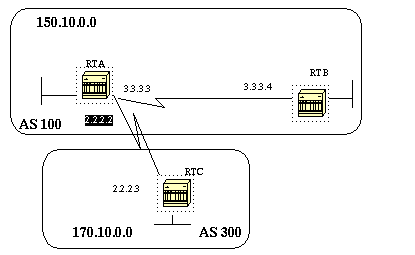
router rip
network 3.0.0.0
network 2.0.0.0
network 150.10.0.0
passive-interface Serial0
redistribute bgp 100 route-map SETMETRIC
neighbor 2.2.2.3 remote-as 300
network 150.10.0.0
match ip-address 1
set metric 2
set metric 5
RTC#
router bgp 300
network 170.10.0.0
neighbor 2.2.2.2 remote-as 100
neighbor 2.2.2.2 route-map STOPUPDATES out
route-map STOPUPDATES permit 10
match ip address 1
access-list 1 deny 170.10.0.0 0.0.255.255
access-list 1 permit 0.0.0.0 255.255.255.255
through these methods one by one.
Network command
router bgp 1
network 192.213.0.0 mask 255.255.0.0
Redistribution
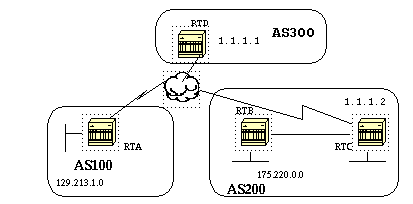
router eigrp 10
network 175.220.0.0
redistribute bgp 200
default-metric 1000 100 250 100 1500
neighbor 1.1.1.1 remote-as 300
network 175.220.0.0 mask 255.255.0.0 (this will limit the networks
originated by your AS to 175.220.0.0)
router eigrp 10
network 175.220.0.0
network 175.220.0.0
redistribute bgp 200
default-metric 1000 100 250 100 1500
neighbor 1.1.1.1 remote-as 300
redistribute eigrp 10 (eigrp will inject 129.213.1.0 again into BGP)
router eigrp 10
network 175.220.0.0
redistribute bgp 200
default-metric 1000 100 250 100 1500
neighbor 1.1.1.1 remote-as 300
neighbor 1.1.1.1 distribute-list 1 out
redistribute eigrp 10
Static routes and redistribution
router eigrp 10
network 175.220.0.0
redistribute bgp 200
default-metric 1000 100 250 100 1500
neighbor 1.1.1.1 remote-as 300
redistribute static
...
ip route 175.220.0.0 255.255.255.0 null0
....
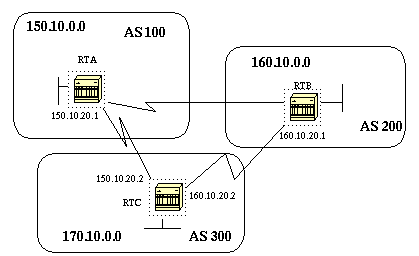
router bgp 100
neighbor 150.10.20.2 remote-as 300
network 150.10.0.0
router bgp 200
neighbor 160.10.20.2 remote-as 300
network 160.10.0.0
router bgp 300
neighbor 150.10.20.1 remote-as 100
neighbor 160.10.20.1 remote-as 200
network 170.10.00
Internal BGP
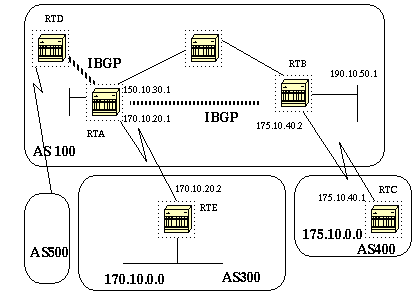
router bgp 100
neighbor 190.10.50.1 remote-as 100
neighbor 170.10.20.2 remote-as 300
network 150.10.0.0
router bgp 100
neighbor 150.10.30.1 remote-as 100
neighbor 175.10.40.1 remote-as 400
network 190.10.50.0
router bgp 400
neighbor 175.10.40.2 remote-as 100
network 175.10.0.0
The BGP decision algorithm
As_path Attribute
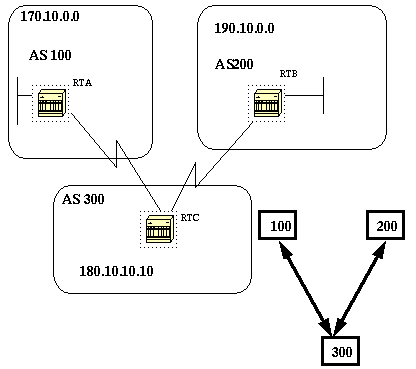
Origin Attribute
indicated with an "e" in the BGP table.
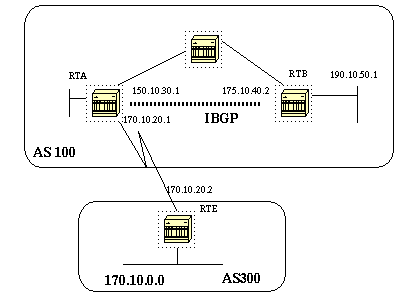
router bgp 100
neighbor 190.10.50.1 remote-as 100
neighbor 170.10.20.2 remote-as 300
network 150.10.0.0
redistribute static
ip route 190.10.0.0 255.255.0.0 null0
router bgp 100
neighbor 150.10.30.1 remote-as 100
network 190.10.50.0
router bgp 300
neighbor 170.10.20.1 remote-as 100
network 170.10.0.0
RTA will also reach 190.10.50.0 via: i (which means, the entry is in
the same AS and the origin is IGP).
RTE will reach 150.10.0.0 via: 100 i (the next AS is 100 and the origin
is IGP).
RTE will also reach 190.10.0.0 via: 100 ? (the next AS is 100 and the
origin is incomplete "?", coming from a static route).
BGP Nexthop Attribute
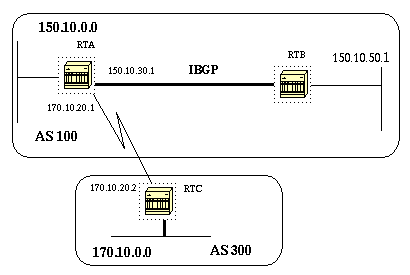
router bgp 100
neighbor 170.10.20.2 remote-as 300
neighbor 150.10.50.1 remote-as 100
network 150.10.0.0
router bgp 100
neighbor 150.10.30.1 remote-as 100
router bgp 300
neighbor 170.10.20.1 remote-as 100
network 170.10.0.0
*RTA will advertise 170.10.0.0 to RTB with a NextHop= 170.10.20.2
(The external NextHop via EBGP is sent via IBGP)
BGP Nexthop (Multiaccess Networks)
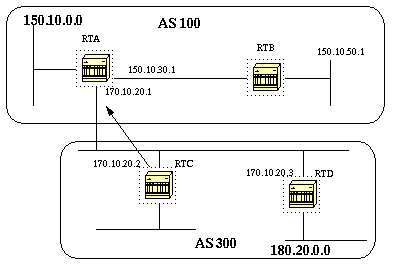
BGP Nexthop (NBMA)
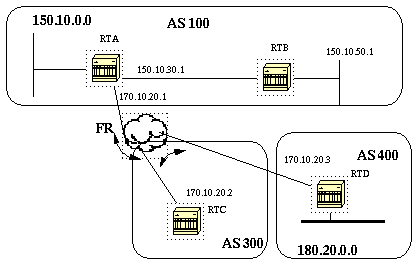
Nexthopself
router bgp 300
neighbor 170.10.20.1 remote-as 100
neighbor 170.10.20.1 next-hop-self
BGP Backdoor
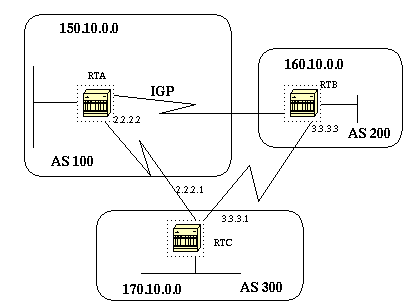
EBGP with a distance of 20 and IGP with a distance higher than 20.
internal-distance:200
local-distance:200
router eigrp 10
network 160.10.0.0
neighbor 2.2.2.1 remote-as 300
network 160.10.0.0 backdoor
Synchronization
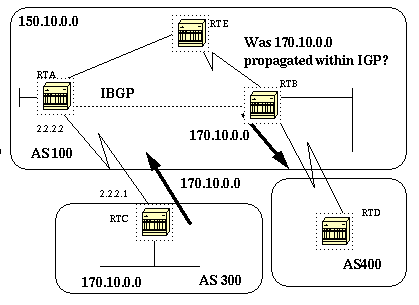
BGP will wait until IGP has propagated the route within the AS and then
will advertise it to external peers. This is called synchronization.
Disabling synchronization
no synchronization.
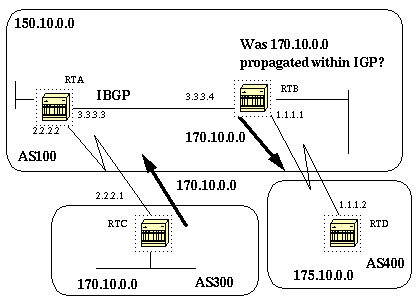
router bgp 100
network 150.10.0.0
neighbor 1.1.1.2 remote-as 400
neighbor 3.3.3.3 remote-as 100
no synchronization (RTB will put 170.10.0.0 in its ip routing table and
will advertise it to RTD even if it does not have an IGP path to 170.10.0.0)
router bgp 400
neighbor 1.1.1.1 remote-as 100
network 175.10.0.0
router bgp 100
network 150.10.0.0
neighbor 3.3.3.4 remote-as 100
Weight Attribute
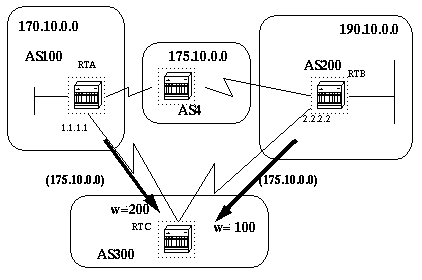
neighbor ip-address filter-list
access-list-number weight weight
router bgp 300
neighbor 1.1.1.1 remote-as 100
neighbor 1.1.1.1 weight 200 (route to 175.10.0.0 from RTA will have 200
weight)
neighbor 2.2.2.2 remote-as 200
neighbor 2.2.2.2 weight 100 (route to 175.10.0.0 from RTB will have 100
weight)
router bgp 300
neighbor 1.1.1.1 remote-as 100
neighbor 1.1.1.1 filter-list 5 weight 200
neighbor 2.2.2.2 remote-as 200
neighbor 2.2.2.2 filter-list 6 weight 100
...
ip as-path access-list 5 permit ^100$ (this will only permit path 100)
ip as-path access-list 6 permit ^200$
...
router bgp 300
neighbor 1.1.1.1 remote-as 100
neighbor 1.1.1.1 route-map setweightin in
neighbor 2.2.2.2 remote-as 200
neighbor 2.2.2.2 route-map setweightin in
...
ip as-path access-list 5 permit ^100$
...
match as-path 5
set weight 200
(anything that applies to access-list 5, i.e. packets from AS100, would
have weight 200)
set weight 100
(anything else would have weight 100)
Local Preference Attribute
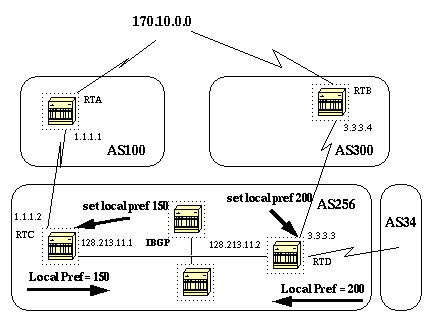
router bgp 256
neighbor 1.1.1.1 remote-as 100
neighbor 128.213.11.2 remote-as 256
bgp default local-preference 150
router bgp 256
neighbor 3.3.3.4 remote-as 300
neighbor 128.213.11.1 remote-as 256
bgp default local-preference 200
router bgp 256
neighbor 3.3.3.4 remote-as 300
neighbor 3.3.3.4 setlocalin in
neighbor 128.213.11.1 remote-as 256
....
ip as-path 7 permit ^300$
...
match as-path 7
set local-preference 400
set local-preference 150
Metric Attribute
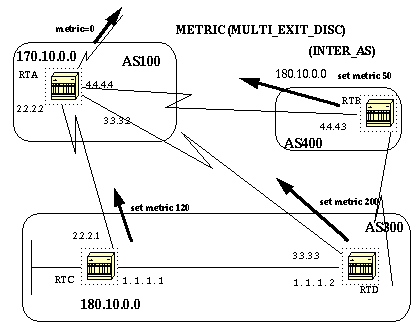
router bgp 100
neighbor 2.2.2.1 remote-as 300
neighbor 3.3.3.3 remote-as 300
neighbor 4.4.4.3 remote-as 400
....
router bgp 300
neighbor 2.2.2.2 remote-as 100
neighbor 2.2.2.2 route-map setmetricout out
neighbor 1.1.1.2 remote-as 300
set metric 120
router bgp 300
neighbor 3.3.3.2 remote-as 100
neighbor 3.3.3.2 route-map setmetricout out
neighbor 1.1.1.1 remote-as 300
set metric 200
router bgp 400
neighbor 4.4.4.4 remote-as 100
neighbor 4.4.4.4 route-map setmetricout out
set metric 50
router bgp 100
neighbor 2.2.21 remote-as 300
neighbor 3.3.3.3 remote-as 300
neighbor 4.4.4.3 remote-as 400
bgp always-compare-med
router bgp 400
redistribute static
default-metric 50
ip route 180.10.0.0 255.255.0.0 null 0
Community Attribute
-no-advertise (Do not advertise this route to any peer)
-internet (Advertise this route to the internet community, any
router belongs to it)
match ip address 1
set community no-advertise
match as-path 1
set community 200 additive
router bgp 100
neighbor 3.3.3.3 remote-as 300
neighbor 3.3.3.3 send-community
neighbor 3.3.3.3 route-map setcommunity out
Route Filtering
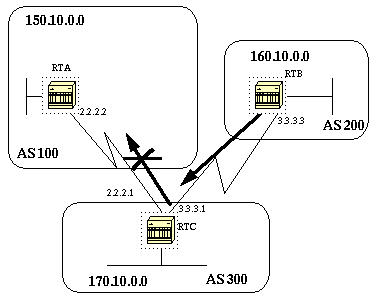
router bgp 300
network 170.10.0.0
neighbor 3.3.3.3 remote-as 200
neighbor 2.2.2.2 remote-as 100
neighbor 2.2.2.2 distribute-list 1 out
(filter out all routing updates about 160.10.x.x)
Path Filtering
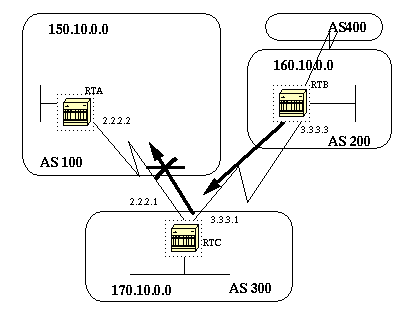
router bgp 300
neighbor 3.3.3.3 remote-as 200
neighbor 2.2.2.2 remote-as 100
neighbor 2.2.2.2 filter-list 1 out (the 1 is the access list number
below)
ip as-path access-list 1 permit .*
If you have an AS400 (see figure above), updates originated by AS400
will have path information of the form (200, 400) with 200 being first and
400 being last. Those updates will match the access list ^200 because they
start with 200 and will be prevented from being sent to RTA which is not
the required behavior.
AS-Regular Expression
A range is a sequence of characters contained within left and right
square brackets. ex: [abcd]
An atom is a single character
^ (Matches the beginning of the input string)
$ (Matches the end of the input string)
\character (Matches the character)
- (Matches a comma (,), left brace ({), right brace (}), the beginning
of the input string, the end of the input string, or a space.
A piece is an atom followed by one of the symbols:
+ (Matches 1 or more sequences of the atom)
? (Matches the atom or the null string)
A branch is a 0 or more concatenated pieces.
a+ at least one occurrence of a should be present
ab?a this will match aa or aba
_100_(via AS100)
^100$ (origin AS100)
^100 .* (coming from AS100)
^$ (originated from this AS)
BGP Community Filtering
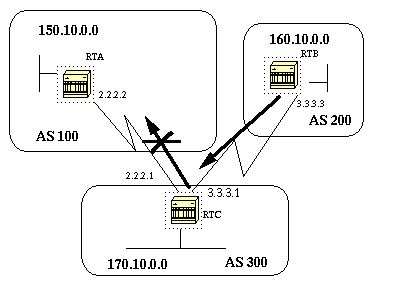
router bgp 200
network 160.10.0.0
neighbor 3.3.3.1 remote-as 300
neighbor 3.3.3.1 send-community
neighbor 3.3.3.1 route-map setcommunity out
match ip address 1
set community no-export
router bgp 200
network 160.10.0.0
neighbor 3.3.3.1 remote-as 300
neighbor 3.3.3.1 send-community
neighbor 3.3.3.1 route-map setcommunity out
match ip address 2
set community 100 200 additive
match community 10 (10 is the community-list number)
set weight 20
router bgp 300
neighbor 3.3.3.3 remote-as 200
neighbor 3.3.3.3 route-map check-community in
match community 1
set weight 20
match community 2 exact
set weight 10
match community 3
ip community-list 2 permit 200
ip community-list 3 permit internet
BGP Neighbors and Route maps
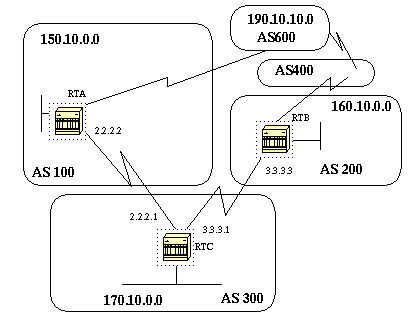
router bgp 300
network 170.10.0.0
neighbor 3.3.3.3 remote-as 200
neighbor 3.3.3.3 route-map stamp in
match as-path 1
set weight 20
1- Updates originating from AS200 to be accepted with weight 20.
2- Updates originating from AS400 to be dropped.
3- Other updates to have a weight of 10.
router bgp 300
network 170.10.0.0
neighbor 3.3.3.3 remote-as 200
neighbor 3.3.3.3 route-map stamp in
match as-path 1
set weight 20
match as-path 2
set weight 10
ip as-path access-list 2 permit ^200 600 .*
Use of set as-path prepend
router bgp 300
network 170.10.0.0
neighbor 2.2.2.2 remote-as 100
neighbor 2.2.2.2 route-map SETPATH out
set as-path prepend 300 300
BGP Peer Groups
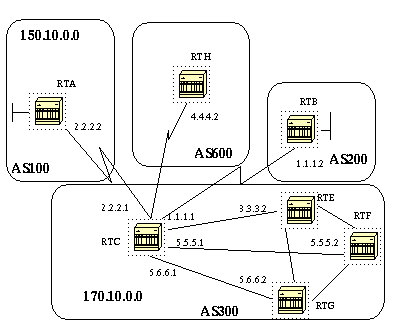
router bgp 300
neighbor internalmap peer-group
neighbor internalmap remote-as 300
neighbor internalmap route-map SETMETRIC out
neighbor internalmap filter-list 1 out
neighbor internalmap filter-list 2 in
neighbor 5.5.5.2 peer-group internalmap
neighbor 6.6.6.2 peer-group internalmap
neighbor 3.3.3.2 peer-group internalmap
neighbor 3.3.3.2 filter-list 3 in
router bgp 300
neighbor externalmap peer-group
neighbor externalmap route-map SETMETRIC
neighbor externalmap filter-list 1 out
neighbor externalmap filter-list 2 in
neighbor 2.2.2.2 remote-as 100
neighbor 2.2.2.2 peer-group externalmap
neighbor 4.4.4.2 remote-as 600
neighbor 4.4.4.2 peer-group externalmap
neighbor 1.1.1.2 remote-as 200
neighbor 1.1.1.2 peer-group externalmap
neighbor 1.1.1.2 filter-list 3 in
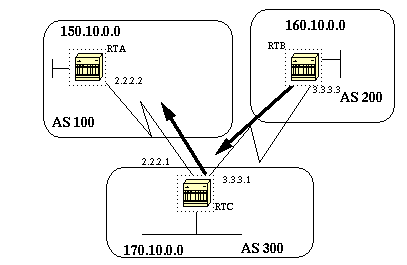
router bgp 200
neighbor 3.3.3.1 remote-as 300
network 160.10.0.0
router bgp 300
neighbor 3.3.3.3 remote-as 200
neighbor 2.2.2.2 remote-as 100
network 170.10.0.0
aggregate-address 160.0.0.0 255.0.0.0
Aggregate Commands
match ip address 1
access-list 1 permit 0.0.0.0 255.255.255.255
router bgp 300
neighbor 3.3.3.3 remote-as 200
neighbor 2.2.2.2 remote-as 100
neighbor 2.2.2.2 remote-as 100
network 170.10.0.0
aggregate-address 160.0.0.0 255.0.0.0 suppress-map CHECK
set origin igp
CIDR example 1
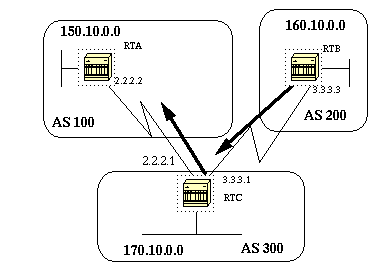
router bgp 200
neighbor 3.3.3.1 remote-as 300
redistribute static (This will generate an update for 160.0.0.0 with the
origin path as *incomplete*)
router bgp 200
network 160.0.0.0 mask 255.0.0.0 (this will mark the update with origin
IGP)
neighbor 3.3.3.1 remote-as 300
redistribute static
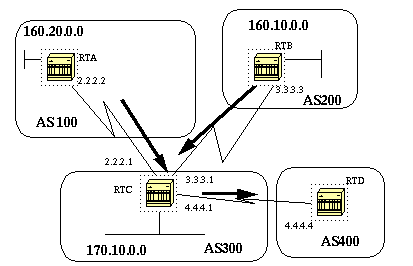
router bgp 200
network 160.10.0.0
neighbor 3.3.3.1 remote-as 300
router bgp 100
network 160.20.0.0
neighbor 2.2.2.1 remote-as 300
router bgp 300
neighbor 3.3.3.3 remote-as 200
neighbor 2.2.2.2 remote-as 100
neighbor 4.4.4.4 remote-as 400
aggregate 160.0.0.0 255.0.0.0 summary-only
(this causes RTC to send RTD updates about 160.0.0.0/8 with no
indication that 160.0.0.0 is actually coming from two different autonomous
systems, this may create loops if RT4 has an entry back into AS100.
router bgp 300
neighbor 3.3.3.3 remote-as 200
neighbor 2.2.2.2 remote-as 100
neighbor 4.4.4.4 remote-as 400
aggregate 160.0.0.0 255.0.0.0 summary-only
aggregate 160.0.0.0 255.0.0.0 as-set
(causes RTC to send RTD updates about 160.0.0.0/8 with an indication
that 160.0.0.0 belongs to a set {100 200})
BGP Confederation
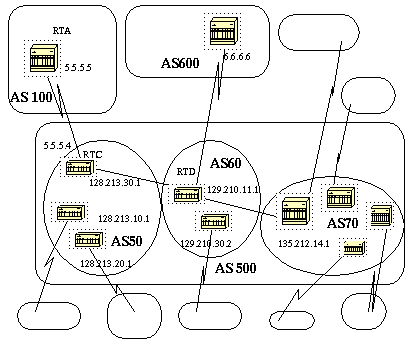
RTC#
router bgp 50
bgp confederation identifier 500
bgp confederation peers 60 70
neighbor 128.213.10.1 remote-as 50 (IBGP connection within AS50)
neighbor 128.213.20.1 remote-as 50 (IBGP connection within AS50)
neighbor 129.210.11.1 remote-as 60 (BGP connection with confederation peer 60)
neighbor 135.212.14.1 remote-as 70 (BGP connection with confederation peer 70)
neighbor 5.5.5.5 remote-as 100 (EBGP connection to external AS100)
router bgp 60
bgp confederation identifier 500
bgp confederation peers 50 70
neighbor 129.210.30.2 remote-as 60 (IBGP connection within AS60)
neighbor 128.213.30.1 remote-as 50(BGP connection with confederation peer
50)
neighbor 135.212.14.1 remote-as 70 (BGP connection with confederation peer
70)
neighbor 6.6.6.6 remote-as 600 (EBGP connection to external AS600)
router bgp 100
neighbor 5.5.5.4 remote-as 500 (EBGP connection to confederation 500)
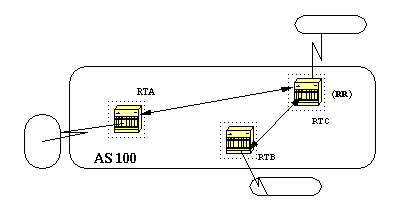
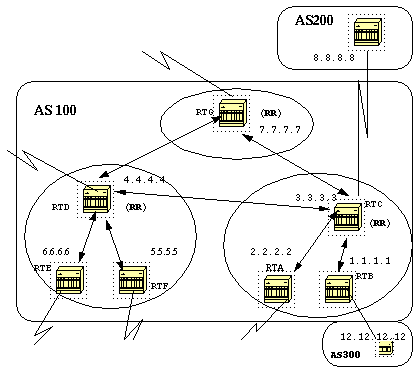
2- Route from a client peer: reflect to all the non-client peers and
also to the client peers.
3- Route from an EBGP peer: send the update to all client and
non-client peers.
RTC#
router bgp 100
neighbor 2.2.2.2 remote-as 100
neighbor 2.2.2.2 route-reflector-client
neighbor 1.1.1.1 remote-as 100
neighbor 1.1.1.1 route-reflector-client
neighbor 7.7.7.7 remote-as 100
neighbor 4.4.4.4 remote-as 100
neighbor 8.8.8.8 remote-as 200
RTB#
router bgp 100
neighbor 3.3.3.3 remote-as 100
neighbor 12.12.12.12 remote-as 300
RTD#
router bgp 100
neighbor 6.6.6.6 remote-as 100
neighbor 6.6.6.6 route-reflector-client
neighbor 5.5.5.5 remote-as 100
neighbor 5.5.5.5 route-reflector-client
neighbor 7.7.7.7 remote-as 100
neighbor 3.3.3.3 remote-as 100
Multiple RRs within a cluster
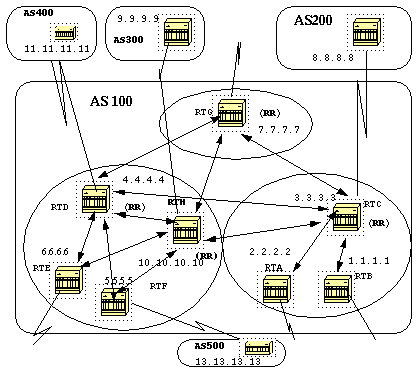
RTH#
router bgp 100
neighbor 4.4.4.4 remote-as 100
neighbor 5.5.5.5 remote-as 100
neighbor 5.5.5.5 route-reflector-client
neighbor 6.6.6.6 remote-as 100
neighbor 6.6.6.6 route-reflector-client
neighbor 7.7.7.7 remote-as 100
neighbor 3.3.3.3 remote-as 100
neighbor 9.9.9.9 remote-as 300
bgp route-reflector 10 (This is the cluster-id)
RTD#
router bgp 100
neighbor 10.10.10.10 remote-as 100
neighbor 5.5.5.5 remote-as 100
neighbor 5.5.5.5 route-reflector-client
neighbor 6.6.6.6 remote-as 100
neighbor 6.6.6.6 route-reflector-client
neighbor 7.7.7.7 remote-as 100
neighbor 3.3.3.3 remote-as 100
neighbor 11.11.11.11 remote-as 400
bgp route-reflector 10 (This is the cluster-id)
RTF#
router bgp 100
neighbor 10.10.10.10 remote-as 100
neighbor 4.4.4.4 remote-as 100
neighbor 13.13.13.13 remote-as 500
RTC#
router bgp 100
neighbor 1.1.1.1 remote-as 100
neighbor 1.1.1.1 route-reflector-client
neighbor 2.2.2.2 remote-as 100
neighbor 2.2.2.2 route-reflector-client
neighbor 4.4.4.4 remote-as 100
neighbor 7.7.7.7 remote-as 100
neighbor 10.10.10.10 remote-as 100
neighbor 8.8.8.8 remote-as 200
RR and conventional BGP speakers
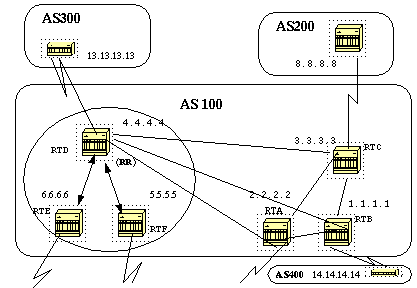
RTD#
router bgp 100
neighbor 6.6.6.6 remote-as 100
neighbor 6.6.6.6 route-reflector-client
neighbor 5.5.5.5 remote-as 100
neighbor 5.5.5.5 route-reflector-client
neighbor 3.3.3.3 remote-as 100
neighbor 2.2.2.2 remote-as 100
neighbor 1.1.1.1 remote-as 100
neighbor 13.13.13.13 remote-as 300
RTC#
router bgp 100
neighbor 4.4.4.4 remote-as 100
neighbor 2.2.2.2 remote-as 100
neighbor 1.1.1.1 remote-as 100
neighbor 14.14.14.14 remote-as 400
Avoiding looping of routing information
Route Flap Dampening
Route dampening (introduced in Cisco IOS version 11.0) is a mechanism to
minimize the instability caused by route flapping and oscillation over the
network. To accomplish this, criteria are defined to identify poorly
behaved routes. A route which is flapping gets a penalty for each flap
(1000). As soon as the cumulative penalty reaches a predefined
"suppress-limit", the advertisement of the route will be suppressed. The
penalty will be exponentially decayed based on a preconfigured "half-time".
Once the penalty
decreases below a predefined "reuse-limit", the route advertisement will be
un-suppressed.
no bgp dampening (will turn off dampening).
bgp dampening <half-life-time> (will change the
half-life-time).
<reuse-value> (range is 1-20000, default is 750).
<suppress-value> (range is 1-20000, default is 2000).
<max-suppress-time> (maximum duration a route can be suppressed,
range is 1-255, default is 4 times half-life-time).
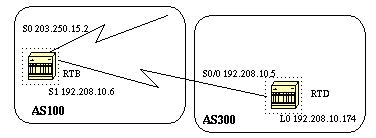
RTB#
hostname RTB
interface Serial0
ip address 203.250.15.2 255.255.255.252
interface Serial1
ip address 192.208.10.6 255.255.255.252
router bgp 100
bgp dampening
network 203.250.15.0
neighbor 192.208.10.5 remote-as 300
RTD#
hostname RTD
interface Loopback0
ip address 192.208.10.174 255.255.255.192
interface Serial0/0
ip address 192.208.10.5 255.255.255.252
router bgp 300
network 192.208.10.0
neighbor 192.208.10.6 remote-as 100
RTB#sh ip bgp
BGP table version is 24, local router ID is 203.250.15.2 Status codes: s
suppressed, d damped, h history, * valid, > best, i - internal Origin
codes: i - IGP, e - EGP, ? - incomplete
Network Next Hop Metric LocPrf Weight Path
*> 192.208.10.0 192.208.10.5 0 0 300 i
*> 203.250.15.0 0.0.0.0 0 32768 i
RTB#sh ip bgp
BGP table version is 24, local router ID is 203.250.15.2 Status codes: s
suppressed, d damped, h history, * valid, > best, i - internal Origin
codes: i - IGP, e - EGP, ? - incomplete
Network Next Hop Metric LocPrf Weight Path
h 192.208.10.0 192.208.10.5 0 0 300 i
*> 203.250.15.0 0.0.0.0 0 32768 i
RTB#sh ip bgp 192.208.10.0
BGP routing table entry for 192.208.10.0 255.255.255.0, version 25
Paths: (1 available, no best path)
300 (history entry)
192.208.10.5 from 192.208.10.5 (192.208.10.174)
Origin IGP, metric 0, external
Dampinfo: penalty 910, flapped 1 times in 0:02:03
The route has been given a penalty for flapping but the penalty is still
below the "suppress limit" (default is 2000). The route is not yet
suppressed. If the route flaps few more times we will see the following:
RTB#sh ip bgp
BGP table version is 32, local router ID is 203.250.15.2 Status codes:
s suppressed, d damped, h history, * valid, > best, i - internal Origin codes:
i - IGP, e - EGP, ? - incomplete
Network Next Hop Metric LocPrf Weight Path
*d 192.208.10.0 192.208.10.5 0 0 300 i
*> 203.250.15.0 0.0.0.0 0 32768 i
RTB#sh ip bgp 192.208.10.0
BGP routing table entry for 192.208.10.0 255.255.255.0, version 32
Paths: (1 available, no best path)
300, (suppressed due to dampening)
192.208.10.5 from 192.208.10.5 (192.208.10.174)
Origin IGP, metric 0, valid, external
Dampinfo: penalty 2615, flapped 3 times in 0:05:18 , reuse in 0:27:00
The route has been dampened (suppressed). The route will be reused when the
penalty reaches the "reuse value", in our case 750 (default).The dampening
information will be purged when the penalty becomes less than half of the
reuse-limit, in our case (750/2=375). The Following are the commands used
to show and clear flap statistics information:
(displays flap statistics for all the paths)
(displays flap statistics for all paths that match the regexp)
(displays flap statistics for all paths that pass the filter)
(displays flap statistics for a single entry)
(displays flap statistics for more specific entries)
(displays flap statistics for all paths from a neighbor)
(clears flap statistics for all routes)
(clears flap statistics for all the paths that match the regexp)
(clears flap statistics for a single entry)
How BGP selects a Path
2-Prefer the largest Weight.
3-If same weight prefer largest Local Preference.
4-If same Local Preference prefer the route that the specified
router has originated.
5-If no route was originated prefer the shorter AS path.
6-If all paths are external prefer the lowest origin code
(IGP<EGP<INCOMPLETE).
7-If origin codes are the same prefer the path with the lowest MED.
8-If path is the same length prefer the External path over Internal.
9-If IGP synchronization is disabled and only internal path remain
prefer the path through the closest IGP neighbor.
10-Prefer the route with the lowest ip address value for BGP
router ID.
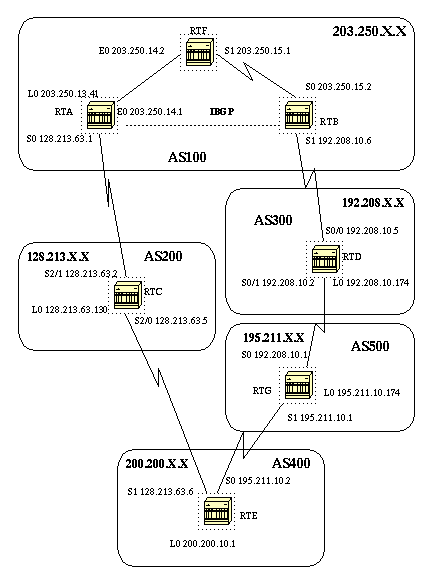
RTA#
hostname RTA
ip subnet-zero
interface Loopback0
ip address 203.250.13.41 255.255.255.0
interface Ethernet0
ip address 203.250.14.1 255.255.255.0
interface Serial0
ip address 128.213.63.1 255.255.255.252
router ospf 10
network 203.250.0.0 0.0.255.255 area 0
router bgp 100
network 203.250.0.0 mask 255.255.0.0
neighbor 128.213.63.2 remote-as 200
neighbor 203.250.15.2 remote-as 100
neighbor 203.250.15.2 update-source Loopback0
RTF#
hostname RTF
ip subnet-zero
interface Ethernet0
ip address 203.250.14.2 255.255.255.0
interface Serial1
ip address 203.250.15.1 255.255.255.252
router ospf 10
network 203.250.0.0 0.0.255.255 area 0
RTB#
hostname RTB
ip subnet-zero
interface Serial0
ip address 203.250.15.2 255.255.255.252
interface Serial1
ip address 192.208.10.6 255.255.255.252
router ospf 10
network 203.250.0.0 0.0.255.255 area 0
router bgp 100
network 203.250.15.0
neighbor 192.208.10.5 remote-as 300
neighbor 203.250.13.41 remote-as 100
RTC#
hostname RTC
ip subnet-zero
interface Loopback0
ip address 128.213.63.130 255.255.255.192
interface Serial2/0
ip address 128.213.63.5 255.255.255.252
!
interface Serial2/1
ip address 128.213.63.2 255.255.255.252
router bgp 200
network 128.213.0.0
neighbor 128.213.63.1 remote-as 100
neighbor 128.213.63.6 remote-as 400
RTD#
hostname RTD
ip subnet-zero
interface Loopback0
ip address 192.208.10.174 255.255.255.192
interface Serial0/0
ip address 192.208.10.5 255.255.255.252
!
interface Serial0/1
ip address 192.208.10.2 255.255.255.252
router bgp 300
network 192.208.10.0
neighbor 192.208.10.1 remote-as 500
neighbor 192.208.10.6 remote-as 100
RTE#
hostname RTE
ip subnet-zero
interface Loopback0
ip address 200.200.10.1 255.255.255.0
interface Serial0
ip address 195.211.10.2 255.255.255.252
interface Serial1
ip address 128.213.63.6 255.255.255.252
clockrate 1000000
router bgp 400
network 200.200.10.0
neighbor 128.213.63.5 remote-as 200
neighbor 195.211.10.1 remote-as 500
RTG#
hostname RTG
ip subnet-zero
interface Loopback0
ip address 195.211.10.174 255.255.255.192
interface Serial0
ip address 192.208.10.1 255.255.255.252
interface Serial1
ip address 195.211.10.1 255.255.255.252
router bgp 500
network 195.211.10.0
neighbor 192.208.10.2 remote-as 300
neighbor 195.211.10.2 remote-as 400
It is always better to use the network command or redistribute static
entries into BGP to advertise networks, rather than redistributing IGP into
BGP. This is why, throughtout this example I will only use the network
command to inject networks into BGP.
RTB#sh ip bgp BGP
table version is 4, local router ID is 203.250.15.2 Status
codes: s suppressed, d damped, h history, * valid, > best, i - internal
Origin codes: i - IGP, e - EGP, ? - incomplete
Network Next Hop Metric LocPrf Weight Path
*i128.213.0.0 128.213.63.2 0 100 0 200 i
*i192.208.10.0 128.213.63.2 100 0 200 400 500
300 i
*i195.211.10.0 128.213.63.2 100 0 200 400 500 i
*i200.200.10.0 128.213.63.2 100 0 200 400 i
*>i203.250.13.0 203.250.13.41 0 100 0 i
*>i203.250.14.0 203.250.13.41 0 100 0 i
*>203.250.15.0 0.0.0.0 0 32768 i
Let me go over the basic notations of the above table. The "i" at the
beginning means that the entry was learned via an internal BGP peer. The
"i" at the end indicates the ORIGIN of the path information to be IGP. The
path info is intuitive. For example network 128.213.0.0 is learned via path
200 with nexthop of 128.213.63.2. Note that any locally generated entry
such as 203.250.15.0 has a nexthop 0.0.0.0.
RTB#sh ip rou
Codes: C - connected, S - static, I - IGRP, R - RIP, M - mobile, B - BGP
D - EIGRP, EX - EIGRP external, O - OSPF, IA - OSPF inter area
E1 - OSPF external type 1, E2 - OSPF external type 2, E - EGP
i - IS-IS, L1 - IS-IS level-1, L2 - IS-IS level-2, * - candidate
default
Gateway of last resort is not set
203.250.13.0 255.255.255.255 is subnetted, 1 subnets
O 203.250.13.41 [110/75] via 203.250.15.1, 02:50:45, Serial0
203.250.15.0 255.255.255.252 is subnetted, 1 subnets
C 203.250.15.0 is directly connected, Serial0
O 203.250.14.0 [110/74] via 203.250.15.1, 02:50:46, Serial0
Well, it doesn't look like any of the BGP entries has made it to the
routing table. There are two problems here:
RTA's configs would be:
RTA#
hostname RTA
ip subnet-zero
interface Loopback0
ip address 203.250.13.41 255.255.255.0
interface Ethernet0
ip address 203.250.14.1 255.255.255.0
interface Serial0
ip address 128.213.63.1 255.255.255.252
router ospf 10
passive-interface Serial0
network 203.250.0.0 0.0.255.255 area 0
network 128.213.0.0 0.0.255.255 area 0
router bgp 100
network 203.250.0.0 mask 255.255.0.0
neighbor 128.213.63.2 remote-as 200
neighbor 203.250.15.2 remote-as 100
neighbor 203.250.15.2 update-source Loopback0
The new BGP table on RTB now looks like this:
RTB#sh ip bgp
BGP table version is 10, local router ID is 203.250.15.2
Status codes: s suppressed, d damped, h history, * valid, > best,
i - internal Origin codes: i - IGP, e - EGP, ? - incomplete
Network Next Hop Metric LocPrf Weight Path
*>i128.213.0.0 128.213.63.2 0 100 0 200 i
*>i192.208.10.0 128.213.63.2 100 0 200 400 500
300 i
*>i195.211.10.0 128.213.63.2 100 0 200 400 500 i
*>i200.200.10.0 128.213.63.2 100 0 200 400 i
*>i203.250.13.0 203.250.13.41 0 100 0 i
*>i203.250.14.0 203.250.13.41 0 100 0 i
*> 203.250.15.0 0.0.0.0 0 32768 i
Note that all the entries have >, which means that BGP is ok with next hop.
Let us look at the routing table now:
RTB#sh ip rou
Codes: C - connected, S - static, I - IGRP, R - RIP, M - mobile, B - BGP
D - EIGRP, EX - EIGRP external, O - OSPF, IA - OSPF inter area
E1 - OSPF external type 1, E2 - OSPF external type 2, E - EGP
i - IS-IS, L1 - IS-IS level-1, L2 - IS-IS level-2, * -
candidate default
Gateway of last resort is not set
203.250.13.0 255.255.255.255 is subnetted, 1 subnets
O 203.250.13.41 [110/75] via 203.250.15.1, 00:04:46, Serial0
203.250.15.0 255.255.255.252 is subnetted, 1 subnets
C 203.250.15.0 is directly connected, Serial0
O 203.250.14.0 [110/74] via 203.250.15.1, 00:04:46, Serial0
128.213.0.0 255.255.255.252 is subnetted, 1 subnets
O 128.213.63.0 [110/138] via 203.250.15.1, 00:04:47, Serial0
Problem 2:
RTB#sh ip rou
Codes: C - connected, S - static, I - IGRP, R - RIP, M - mobile, B - BGP
D - EIGRP, EX - EIGRP external, O - OSPF, IA - OSPF inter area
E1 - OSPF external type 1, E2 - OSPF external type 2, E - EGP
i - IS-IS, L1 - IS-IS level-1, L2 - IS-IS level-2, * -
candidate default
Gateway of last resort is not set
B 200.200.10.0 [200/0] via 128.213.63.2, 00:01:07
B 195.211.10.0 [200/0] via 128.213.63.2, 00:01:07
B 192.208.10.0 [200/0] via 128.213.63.2, 00:01:07
203.250.13.0 is variably subnetted, 2 subnets, 2 masks
O 203.250.13.41 255.255.255.255
[110/75] via 203.250.15.1, 00:12:37, Serial0
B 203.250.13.0 255.255.255.0 [200/0] via 203.250.13.41, 00:01:08
203.250.15.0 255.255.255.252 is subnetted, 1 subnets
C 203.250.15.0 is directly connected, Serial0
O 203.250.14.0 [110/74] via 203.250.15.1, 00:12:37, Serial0
128.213.0.0 is variably subnetted, 2 subnets, 2 masks
B 128.213.0.0 255.255.0.0 [200/0] via 128.213.63.2, 00:01:08
O 128.213.63.0 255.255.255.252
[110/138] via 203.250.15.1, 00:12:37, Serial0
The routing table looks fine, but there is no way we can reach those
networks because RTF in the middle does not know how to reach them:
RTF#sh ip rou
Codes: C - connected, S - static, I - IGRP, R - RIP, M - mobile, B - BGP
D - EIGRP, EX - EIGRP external, O - OSPF, IA - OSPF inter area
E1 - OSPF external type 1, E2 - OSPF external type 2, E - EGP
i - IS-IS, L1 - IS-IS level-1, L2 - IS-IS level-2, * -
candidate default
Gateway of last resort is not set
203.250.13.0 255.255.255.255 is subnetted, 1 subnets
O 203.250.13.41 [110/11] via 203.250.14.1, 00:14:15, Ethernet0
203.250.15.0 255.255.255.252 is subnetted, 1 subnets
C 203.250.15.0 is directly connected, Serial1
C 203.250.14.0 is directly connected, Ethernet0
128.213.0.0 255.255.255.252 is subnetted, 1 subnets
O 128.213.63.0 [110/74] via 203.250.14.1, 00:14:15, Ethernet0
So, turning off synchronization in this situation did not help this
particular issue, but we will need it for other issues later on. Let's
redistribute OSPF into BGP on RTA , with a metric of 2000.
RTA#
hostname RTA
ip subnet-zero
interface Loopback0
ip address 203.250.13.41 255.255.255.0
interface Ethernet0
ip address 203.250.14.1 255.255.255.0
interface Serial0
ip address 128.213.63.1 255.255.255.252
router ospf 10
redistribute bgp 100 metric 2000 subnets
passive-interface Serial0
network 203.250.0.0 0.0.255.255 area 0
network 128.213.0.0 0.0.255.255 area 0
router bgp 100
network 203.250.0.0 mask 255.255.0.0
neighbor 128.213.63.2 remote-as 200
neighbor 203.250.15.2 remote-as 100
neighbor 203.250.15.2 update-source Loopback0
The routing table will look like this:
RTB#sh ip rou
Codes: C - connected, S - static, I - IGRP, R - RIP, M - mobile, B - BGP
D - EIGRP, EX - EIGRP external, O - OSPF, IA - OSPF inter area
E1 - OSPF external type 1, E2 - OSPF external type 2, E - EGP
i - IS-IS, L1 - IS-IS level-1, L2 - IS-IS level-2, * -
candidate default
Gateway of last resort is not set
O E2 200.200.10.0 [110/2000] via 203.250.15.1, 00:00:14, Serial0
O E2 195.211.10.0 [110/2000] via 203.250.15.1, 00:00:14, Serial0
O E2 192.208.10.0 [110/2000] via 203.250.15.1, 00:00:14, Serial0
203.250.13.0 is variably subnetted, 2 subnets, 2 masks
O 203.250.13.41 255.255.255.255
[110/75] via 203.250.15.1, 00:00:15, Serial0
O E2 203.250.13.0 255.255.255.0
[110/2000] via 203.250.15.1, 00:00:15, Serial0
203.250.15.0 255.255.255.252 is subnetted, 2 subnets
C 203.250.15.8 is directly connected, Loopback1
C 203.250.15.0 is directly connected, Serial0
O 203.250.14.0 [110/74] via 203.250.15.1, 00:00:15, Serial0
128.213.0.0 is variably subnetted, 2 subnets, 2 masks
O E2 128.213.0.0 255.255.0.0 [110/2000] via 203.250.15.1,
00:00:15,Serial0
O 128.213.63.0 255.255.255.252
[110/138] via 203.250.15.1, 00:00:16, Serial0
The BGP entries have disappeared because OSPF has a better distance
(110) than internal bgp (200).
RTA#
hostname RTA
ip subnet-zero
interface Loopback0
ip address 203.250.13.41 255.255.255.0
interface Ethernet0
ip address 203.250.14.1 255.255.255.0
interface Ethernet0
ip address 203.250.14.1 255.255.255.0
interface Serial0
ip address 128.213.63.1 255.255.255.252
router ospf 10
redistribute bgp 100 metric 2000 subnets
passive-interface Serial0
network 203.250.0.0 0.0.255.255 area 0
network 128.213.0.0 0.0.255.255 area 0
router bgp 100
no synchronization
network 203.250.0.0 mask 255.255.0.0
neighbor 128.213.63.2 remote-as 200
neighbor 203.250.15.2 remote-as 100
neighbor 203.250.15.2 update-source Loopback0
RTB#
hostname RTB
ip subnet-zero
interface Serial0
ip address 203.250.15.2 255.255.255.252
interface Serial1
ip address 192.208.10.6 255.255.255.252
router ospf 10
redistribute bgp 100 metric 1000 subnets
passive-interface Serial1
network 203.250.0.0 0.0.255.255 area 0
network 192.208.0.0 0.0.255.255 area 0
router bgp 100
no synchronization
network 203.250.15.0
neighbor 192.208.10.5 remote-as 300
neighbor 203.250.13.41 remote-as 100
And the BGP tables look like this:
RTA#sh ip bgp
BGP table version is 117, local router ID is 203.250.13.41
Status codes: s suppressed, d damped, h history, * valid, > best,
i -internal Origin codes: i - IGP, e - EGP, ? - incomplete
Network Next Hop Metric LocPrf Weight Path
*> 128.213.0.0 128.213.63.2 0 0 200 i
*>i192.208.10.0 192.208.10.5 0 100 0 300 i
*>i195.211.10.0 192.208.10.5 100 0 300 500 i
* 128.213.63.2 0 200 400 500 i
*> 200.200.10.0 128.213.63.2 0 200 400 i
*> 203.250.13.0 0.0.0.0 0 32768 i
*> 203.250.14.0 0.0.0.0 0 32768 i
*>i203.250.15.0 203.250.15.2 0 100 0 i
RTB#sh ip bgp
BGP table version is 12, local router ID is 203.250.15.10
Status codes: s suppressed, d damped, h history, * valid, > best,
i -internal Origin codes: i - IGP, e - EGP, ? - incomplete
Network Next Hop Metric LocPrf Weight Path
*>i128.213.0.0 128.213.63.2 0 100 0 200 i
* 192.208.10.5 0 300 500 400
200 i
*> 192.208.10.0 192.208.10.5 0 0 300 i
*> 195.211.10.0 192.208.10.5 0 300 500 i
*>i200.200.10.0 128.213.63.2 100 0 200 400 i
* 192.208.10.5 0 300 500 400 i
*>i203.250.13.0 203.250.13.41 0 100 0 i
*>i203.250.14.0 203.250.13.41 0 100 0 i
*> 203.250.15.0 0.0.0.0 0 32768 i
There are multiple ways to design our network to talk to the two different ISPs
AS200 and AS300. One way is to have a primary ISP and a backup ISP. We
could learn partial routes from one of the ISP's and default routes to both
ISPs. In this example, I have chosen to receive partial routes from AS200
and only local routes from AS300. Both RTA and RTB are generating default
routes into OSPF with RTB being more preferred (lower metric). This way I
could balance outgoing traffic between the two ISPs.
RTA#
hostname RTA
ip subnet-zero
interface Loopback0
ip address 203.250.13.41 255.255.255.0
interface Ethernet0
ip address 203.250.14.1 255.255.255.0
interface Serial0
ip address 128.213.63.1 255.255.255.252
router ospf 10
redistribute bgp 100 metric 2000 subnets
passive-interface Serial0
network 203.250.0.0 0.0.255.255 area 0
network 128.213.0.0 0.0.255.255 area 0
default-information originate metric 2000
router bgp 100
no synchronization
network 203.250.13.0
network 203.250.14.0
neighbor 128.213.63.2 remote-as 200
neighbor 128.213.63.2 route-map setlocalpref in
neighbor 203.250.15.2 remote-as 100
neighbor 203.250.15.2 update-source Loopback0
ip classless
ip default-network 200.200.0.0
route-map setlocalpref permit 10
set local-preference 200
On RTA, the local preference for routes coming from AS200 is set to 200. I
have also picked network 200.200.0.0 to be the candidate default, using the
"ip default-network command".
RTF#
hostname RTF
ip subnet-zero
interface Ethernet0
ip address 203.250.14.2 255.255.255.0
interface Serial1
ip address 203.250.15.1 255.255.255.252
router ospf 10
network 203.250.0.0 0.0.255.255 area 0
ip classless
RTB#
hostname RTB
ip subnet-zero
interface Loopback1
ip address 203.250.15.10 255.255.255.252
interface Serial0
ip address 203.250.15.2 255.255.255.252
!
interface Serial1
ip address 192.208.10.6 255.255.255.252
router ospf 10
redistribute bgp 100 metric 1000 subnets
passive-interface Serial1
network 203.250.0.0 0.0.255.255 area 0
network 192.208.10.6 0.0.0.0 area 0
default-information originate metric 1000
!
router bgp 100
no synchronization
network 203.250.15.0
neighbor 192.208.10.5 remote-as 300
neighbor 192.208.10.5 route-map localonly in
neighbor 203.250.13.41 remote-as 100
!
ip classless
ip default-network 192.208.10.0
ip as-path access-list 1 permit ^300$
route-map localonly permit 10
match as-path 1
set local-preference 300
For RTB, the local preference for updates coming in from AS300 is set to
300 which is higher than the IBGP updates coming in from RTA. This way
AS100 will pick RTB for AS300's local routes. Any other routes on RTB (if
they exist) will be sent internally with a local preference of 100 which is
lower than 200 coming in from RTA and this way RTA will be preferred. Note
that I have only advertised AS300's local routes. Any path info that does
not match ^300$ will be dropped. If you wanted to advertise the local
routes and the neighbor routes (customers of the ISP) you can use the
following: ^300_[0-9]*
This is the output of the regular expression indicating AS300's local
routes:
RTB#sh ip bgp regexp ^300$
BGP table version is 14, local router ID is 203.250.15.10
Status codes: s suppressed, d damped, h history, * valid, > best, i -
internal
Origin codes: i - IGP, e - EGP, ? - incomplete
Network Next Hop Metric LocPrf Weight Path
*> 192.208.10.0 192.208.10.5 0 300 0 300
RTC#
hostname RTC
ip subnet-zero
interface Loopback0
ip address 128.213.63.130 255.255.255.192
interface Serial2/0
ip address 128.213.63.5 255.255.255.252
!
interface Serial2/1
ip address 128.213.63.2 255.255.255.252
router bgp 200
network 128.213.0.0
aggregate-address 128.213.0.0 255.255.0.0 summary-only
neighbor 128.213.63.1 remote-as 100
neighbor 128.213.63.1 distribute-list 1 out
neighbor 128.213.63.6 remote-as 400
ip classless
access-list 1 deny 195.211.0.0 0.0.255.255
access-list 1 permit any
On RTC, I have aggregated 128.213.0.0/16 and indicated the specific routes
to be injected into AS100. If the ISP refuses to do this task then you have
to filter on the incoming end of AS100.
RTD#
hostname RTD
ip subnet-zero
interface Loopback0
ip address 192.208.10.174 255.255.255.192
!
interface Serial0/0
ip address 192.208.10.5 255.255.255.252
!
interface Serial0/1
ip address 192.208.10.2 255.255.255.252
router bgp 300
network 192.208.10.0
neighbor 192.208.10.1 remote-as 500
neighbor 192.208.10.6 remote-as 100
RTG#
hostname RTG
ip subnet-zero
interface Loopback0
ip address 195.211.10.174 255.255.255.192
interface Serial0
ip address 192.208.10.1 255.255.255.252
interface Serial1
ip address 195.211.10.1 255.255.255.252
router bgp 500
network 195.211.10.0
aggregate-address 195.211.0.0 255.255.0.0 summary-only
neighbor 192.208.10.2 remote-as 300
neighbor 192.208.10.2 send-community
neighbor 192.208.10.2 route-map setcommunity out
neighbor 195.211.10.2 remote-as 400
!
ip classless
access-list 1 permit 195.211.0.0 0.0.255.255
access-list 2 permit any
access-list 101 permit ip 195.211.0.0 0.0.255.255 host 255.255.0.0
route-map setcommunity permit 20
match ip address 2
!
route-map setcommunity permit 10
match ip address 1
set community no-export
On RTG, I have demonstrated the use of community filtering by adding a
no-export community to 195.211.0.0 updates towards RTD. This way RTD will
not export that route to RTB. It doesn't matter in our case because RTB is
not accepting these routes anyway.
RTE#
hostname RTE
ip subnet-zero
interface Loopback0
ip address 200.200.10.1 255.255.255.0
interface Serial0
ip address 195.211.10.2 255.255.255.252
interface Serial1
ip address 128.213.63.6 255.255.255.252
router bgp 400
network 200.200.10.0
aggregate-address 200.200.0.0 255.255.0.0 summary-only
neighbor 128.213.63.5 remote-as 200
neighbor 195.211.10.1 remote-as 500
ip classless
RTA#sh ip bgp
BGP table version is 21, local router ID is 203.250.13.41
Status codes: s suppressed, d damped, h history, * valid, > best, i -
internal
Origin codes: i - IGP, e - EGP, ? - incomplete
Network Next Hop Metric LocPrf Weight Path
*> 128.213.0.0 128.213.63.2 0 200 0 200 i
*>i192.208.10.0 192.208.10.5 0 300 0 300 i
*> 200.200.0.0/16 128.213.63.2 200 0 200 400 i
*> 203.250.13.0 0.0.0.0 0 32768 i
*> 203.250.14.0 0.0.0.0 0 32768 i
*>i203.250.15.0 203.250.15.2 0 100 0 i
RTA#sh ip rou
Codes: C - connected, S - static, I - IGRP, R - RIP, M - mobile, B - BGP
D - EIGRP, EX - EIGRP external, O - OSPF, IA - OSPF inter area
E1 - OSPF external type 1, E2 - OSPF external type 2, E - EGP
i - IS-IS, L1 - IS-IS level-1, L2 - IS-IS level-2, * -
candidate default
Gateway of last resort is 128.213.63.2 to network 200.200.0.0
192.208.10.0 is variably subnetted, 2 subnets, 2 masks
O E2 192.208.10.0 255.255.255.0
[110/1000] via 203.250.14.2, 00:41:25, Ethernet0
O 192.208.10.4 255.255.255.252
[110/138] via 203.250.14.2, 00:41:25, Ethernet0
C 203.250.13.0 is directly connected, Loopback0
203.250.15.0 is variably subnetted, 3 subnets, 3 masks
O 203.250.15.10 255.255.255.255
[110/75] via 203.250.14.2, 00:41:25, Ethernet0
O 203.250.15.0 255.255.255.252
[110/74] via 203.250.14.2, 00:41:25, Ethernet0
B 203.250.15.0 255.255.255.0 [200/0] via 203.250.15.2, 00:41:25
C 203.250.14.0 is directly connected, Ethernet0
128.213.0.0 is variably subnetted, 2 subnets, 2 masks
B 128.213.0.0 255.255.0.0 [20/0] via 128.213.63.2, 00:41:26
C 128.213.63.0 255.255.255.252 is directly connected, Serial0
B* 200.200.0.0 255.255.0.0 [20/0] via 128.213.63.2, 00:02:38
RTF#sh ip rou
Codes: C - connected, S - static, I - IGRP, R - RIP, M - mobile, B - BGP
D - EIGRP, EX - EIGRP external, O - OSPF, IA - OSPF inter area
E1 - OSPF external type 1, E2 - OSPF external type 2, E - EGP
i - IS-IS, L1 - IS-IS level-1, L2 - IS-IS level-2, * -
candidate default
Gateway of last resort is 203.250.15.2 to network 0.0.0.0
192.208.10.0 is variably subnetted, 2 subnets, 2 masks
O E2 192.208.10.0 255.255.255.0
[110/1000] via 203.250.15.2, 00:48:50, Serial1
O 192.208.10.4 255.255.255.252
[110/128] via 203.250.15.2, 01:12:09, Serial1
203.250.13.0 is variably subnetted, 2 subnets, 2 masks
O 203.250.13.41 255.255.255.255
[110/11] via 203.250.14.1, 01:12:09, Ethernet0
O E2 203.250.13.0 255.255.255.0
[110/2000] via 203.250.14.1, 01:12:09, Ethernet0
203.250.15.0 is variably subnetted, 2 subnets, 2 masks
O 203.250.15.10 255.255.255.255
[110/65] via 203.250.15.2, 01:12:09, Serial1
C 203.250.15.0 255.255.255.252 is directly connected, Serial1
C 203.250.14.0 is directly connected, Ethernet0
128.213.0.0 is variably subnetted, 2 subnets, 2 masks
O E2 128.213.0.0 255.255.0.0
[110/2000] via 203.250.14.1, 00:45:01, Ethernet0
O 128.213.63.0 255.255.255.252
[110/74] via 203.250.14.1, 01:12:11, Ethernet0
O E2 200.200.0.0 255.255.0.0 [110/2000] via 203.250.14.1, 00:03:47,
Ethernet0
O*E2 0.0.0.0 0.0.0.0 [110/1000] via 203.250.15.2, 00:03:33, Serial1
Note RTF's routing table which indicates that networks local to AS300 such
as 192.208.10.0 are to be reached via RTB. Other known networks such as
200.200.0.0 are to be reached via RTA. The gateway of last resort is set to
RTB. In case something happens to the connection between RTB and RTD, then
the default advertised by RTA will kick in with a metric of 2000.
RTB#sh ip bgp
BGP table version is 14, local router ID is 203.250.15.10
Status codes: s suppressed, d damped, h history, * valid, > best, i -
internal
Origin codes: i - IGP, e - EGP, ? - incomplete
Network Next Hop Metric LocPrf Weight Path
*>i128.213.0.0 128.213.63.2 0 200 0 200 i
*> 192.208.10.0 192.208.10.5 0 300 0 300 i
*>i200.200.0.0/16 128.213.63.2 200 0 200 400 i
*>i203.250.13.0 203.250.13.41 0 100 0 i
*>i203.250.14.0 203.250.13.41 0 100 0 i
*> 203.250.15.0 0.0.0.0 0 32768 i
RTB#sh ip rou
Codes: C - connected, S - static, I - IGRP, R - RIP, M - mobile, B - BGP
D - EIGRP, EX - EIGRP external, O - OSPF, IA - OSPF inter area
E1 - OSPF external type 1, E2 - OSPF external type 2, E - EGP
i - IS-IS, L1 - IS-IS level-1, L2 - IS-IS level-2, * -
candidate default
Gateway of last resort is 192.208.10.5 to network 192.208.10.0
* 192.208.10.0 is variably subnetted, 2 subnets, 2 masks
B* 192.208.10.0 255.255.255.0 [20/0] via 192.208.10.5, 00:50:46
C 192.208.10.4 255.255.255.252 is directly connected, Serial1
203.250.13.0 is variably subnetted, 2 subnets, 2 masks
O 203.250.13.41 255.255.255.255
[110/75] via 203.250.15.1, 01:20:33, Serial0
O E2 203.250.13.0 255.255.255.0
[110/2000] via 203.250.15.1, 01:15:40, Serial0
203.250.15.0 255.255.255.252 is subnetted, 2 subnets
C 203.250.15.8 is directly connected, Loopback1
C 203.250.15.0 is directly connected, Serial0
O 203.250.14.0 [110/74] via 203.250.15.1, 01:20:33, Serial0
128.213.0.0 is variably subnetted, 2 subnets, 2 masks
O E2 128.213.0.0 255.255.0.0 [110/2000] via 203.250.15.1, 00:46:55,
Serial0
O 128.213.63.0 255.255.255.252
[110/138] via 203.250.15.1, 01:20:34, Serial0
O E2 200.200.0.0 255.255.0.0 [110/2000] via 203.250.15.1, 00:05:42,
Serial0
Copyright 1996 Cisco Systems Inc.